#i even have made up a Future Map including new landscaping and zones
Text
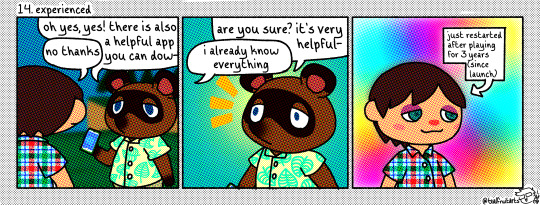
guess what I've been fixating on
#animal crossing#animal crossing new horizons#acnh#tom nook#smth smth#yeah ive just been playing acnh again. sorry#i just unlocked terraforming this morning (as of when im creating the post on monday not when its posted on thursday)#so hopefully by the time this is posted ill have gotten some rly nice street patterns made up#i found some pretty good ones but the way they were set up was like. not exactly what i need? so im trying to like#rip them off ig??? is that bad? idk. im gonna put my own spin on em ig#im just not super good at making convincing like...sidewalks w depth to them and such#anyway hopefully this time around i can really get my island looking as baller as i want#the reason i restarted was bc id fucked my island up so thoroughly that i wasnt even sure what to do w it anymore#or where to start w it#also my plaza was SUPER close to the airport.#so i chose a different layout this time where the plaza is like in the middle right area of it#more room for an entrance and such#i even have made up a Future Map including new landscaping and zones#so ill get to that over the next few days since i have time off work#also! this is the first entry ive made using my new smth smth tools#namely the automatic halftone-ify-er and a custom hand-drawn font#it took a bit less time to make this one since i didnt have to 1. hand write the dialogue and 2. think about the specific halftone colors#im still sticking to a limited palette (specifically 256 web safe colors) just cuz#but yeah. if you have actually read all of this and you have thoughts on the look of this one vs the previous ones lmk 🩵 thanks#also have a good day and drink some water :)
48 notes
·
View notes
Text
DID
this all really happen?
the way it’s written, no—
scratched into the spiral bound, composition,
college-ruled everything. each waking moment
and fights and fears.
and the dreams.
including those crushes from afar with code names
that I must piece together from hints over months and years,
and then tracing back cryptic love notes tucked into lockers
now pinned as if evidence pointing to the mens rea—
the furtive phone calls in hushed tones from my bathroom
as if my parents didn’t notice me flush and steal myself away
from the dinner table and the nightly status reports.
the secrecy (and the hormones)
(and the embarrassment of my existence)
(but mostly the hormones) blooming acne
across my chin, my forehead, my nose
within the grooves of its parentheses
willing its contents—each pore—to shrink into an afterthought.
I remember now how I had prayed to God
to absolve my skin problems and to solve my boy ones.
even bargained with Him in bed that I’d stop touching myself—
or at least a bit less—as if these whiteheads
were His chosen form of punishment.
a dozen constellations across my shoulders
from which my mother would weave the story of her same hidden shame,
shared scars and bumps across our backs
like labels in Braille of all the parts I want to hide,
she promised: it’ll lessen and pass with time.
yet it still manages to haunt the next generation.
pull out the red string and the pins
to map the evidence, the eye witness accounts,
the threats and the retaliation and the heartache
onto the faded bamboo floors of my parents’ house.
the times I willed myself not to cry, stone woman
as my mother avalanched again over the granite before me
her voice booming and crumbling daring to swallow us.
the way I stoically thrilled in the lust of our mutual destruction,
first: the sticky salt of our wounds lashed by sharp tongues
and second: the umami of it seared and grilled to perfection.
still bleeding. medium rare.
or when my father stampeded the room. seeing red.
throwing a metal water bottle, denting it permanently
against the wall then landing on the cold tile.
how their swear words were only ever in English
(that’s when I knew shit was serious)
a rare violence uncondoned by both their mothers’ tongues.
I’m just realizing now:
no wonder my brother and I,
or I’ll just speak for myself, why I
still burst into tears in the middle of their war zone,
or whatever else might feel remotely like it.
I now know instead of acting as
an unsolicited diplomat caught in the crossfire
it’s safer to seek asylum in the Switzerland of the next room,
one ear still wired to their rising voices (I can’t help it)
and their talking points, only to draft peace treaties
for a civil war where they’ve long forgotten
what it is they’re really fighting about anymore.
but back then, this was the only way
to snap them out of self-destruct mode
by overriding their programming with the parental unit fail-safe.
their child crying.
I could walk backwards through it with my eyes closed
and show you exactly how the sun slants through the windows.
how in late spring afternoon the crystals hanging in the dining room
explode a universe of rainbows, little galaxies of light
scattered among our dark matter, across the white walls
and the floors and the crumbs on the pale table cloth.
I could point out all the favorite sun spots of Tiger and Lily
(may he rest in peace)
and somehow always end up back at the grand piano.
there is a tenderness only fingertips know.
dig out the mental blueprints from the archives.
the different schools. the cliques and the quacks.
the start of another year.
short shorts and sweaters.
(refer to your diaryjournals for the details).
and then another new journal.
how they all somehow begin with the just-after-waking
subtle scent of short stories germinating in my mind.
they seem to disappear just before I can finish transcribing them
and then I’m left empty handed, dumfounded,
foolish and doubting and then writing the only kinds of stories I do know,
the ones I’m still learning to place in the light
sprouting tender roots between sheets of paper,
pressed tightly like all those flower petals—
if only I could preserve their bright pigment tones.
but even imagination fades.
and seemingly so do memories.
these spines loosely bound and knees and elbows
now cracked, scuffed, and crinkled.
just a bit creased and water damaged. over the years.
but mostly tears—watermarks from another era.
once, an errant sprinkler jet from the lawn
tap tap tapped against my bedroom window
just barely cracked open, as fate would have it.
waterlogged stacks of books my pillars
now pink and black and blue with mold
and flooded the bamboo floors.
trying to put out the wrong fires
a decade too late, or maybe the right fires
as in the written ones, to destroy the evidence.
I now keep them sealed in a plastic box.
I plead the fifth.
there must be some limit after all these years,
when it’s way too late to apologize anyway—
I’ve considered, and then talked myself down,
from texting or DMing all the people I have wronged.
and memory serves no one now.
if my handwriting has changed at least a dozen times
does that mean I’ve lived a dozen different lives?
the Hubba Bubba gum tape chewing preteen
blowing bubbles over every i and j and under each !
and then there’s the jagged purple glitter pen cursive
as if going slower helps it turn out better—
one of those things you realize
later in life isn’t always true.
there’s the one seemingly always in a rush,
skinny and slanted and caffeinated
(there are coffee spill stains to prove)
always as if she’s just about to topple over.
breathe, I want to tell her, no need to move so fast.
you will concuss yourself doing so.
and two weeks later also topple down the stairs.
(both true stories.) life will force you to slow down.
I almost forget the one more rounded and grounded
printed in ballpoint extra fine so as not to bleed
but what’s the cost of living for the sake of perfection?
what even is my handwriting now?
I had to dig out one of my scrap paper lists to figure out
how its a blend, less measured and more movement
without being driven purely by entropy.
loosely held together.
and now, how often do I write,
like with pen and paper
the letters carved and inked
their ghosts passing through the walls between pages
bumping up against other memories.
these lives and voices call out to me
across the decades, some more familiar than others
almost like specimens in a museum glass box
too fragile for the dust or the humidity
or the air or the light of day.
I’m an archeologist glowing at her simple discovery
which really just involves showing up onsite
and digging and dusting and continued search
over and over into the pits of my being
delicately brushing away at the dirt around my bones,
the silt and sediment compressing into a cross section
of history held in my hand.
look! here it is.
so I write again,
if only for this moment
to leave my future self some clues
(in no particular order):
the return of my freckles.
Craigslist apartment daydreams.
I’m building my callouses learning a new landscape
of metal strings and broken chords. say a little prayer.
tonight, I made choong yao bang from scratch with Mom.
I’ve been staying up way too late
(it’s 4:35am right now... why?)
and then falling asleep to ASMR videos (specifically, Emma).
Mom and Dad are actually not fighting much these days
despite spending all day under the same roof
(find your Google doc, love in the time of quarantine).
my younger self might not even recognize
these people inhabiting our same house.
Mom and Dad are both still here.
and I’m trying not to take it all for granted,
I promise.
we’re together for now but he’s gone again
(eerily, much like 10 years ago but this time on his own terms)
or at least he’s far away, who knows,
who’s to say. we’re giving him time and space.
and we’re learning how to hold each other
while we fall apart, sometimes all at the same time.
usually in different ways.
how I’m scared and excited for my life
to unfurl one leaf at a time.
allowing myself the gift, the anticipation,
the surprise, and then counting the splits.
reach for the sunlight, keep reaching.
and I still don’t know what I wanna be when I grow up
but when have I ever had it all figured out
and what fun is that.
and a note to my younger self:
PS—not only will you continue to write for emotional release
(reference my pure bewilderment of this cathartic power
in diaryjournal dated February 10, 2007)
you will also connect with other humans in your words
and we’ll play in our world and revel in theirs too.
keep writing, for yourself. and dare to share it with others.
gather what others
refer to as the weeds,
make a bouquet,
blow and scatter
the dandelion seeds.
#writing#poetry#poem#words#poets on tumblr#new poets society#spilled ink#spilled poetry#reflection#i found old journals#late night writings#late night poetry#4am#spilled thoughts#poets corner#written by me#writing about writing
3 notes
·
View notes
Link
St. Paul-based cartoonist Andy Singer has never owned a car, even though he's lived, over the last 47 years, in places as diverse as New York City, Ithaca, Oakland, Boston, and now the Twin Cities. He's clearly a minority among Americans, but he's made a career out of using art to convince others to rethink their romance with the automobile.
His latest is Why We Drive, a book released late this summer that uses political cartoons and historical photos to make the case. Many of his main arguments are familiar: he's anti-sprawl, pro-public transportation, pro-biking, and against the types of hidden government incentives that make these policies difficult to put in place.
But Singer takes a more visual approach to advocate for sustainable living. He chatted with Cities about his new book and how he's used his work as a cartoonist to make arresting visual arguments in favor of alternative transportation.
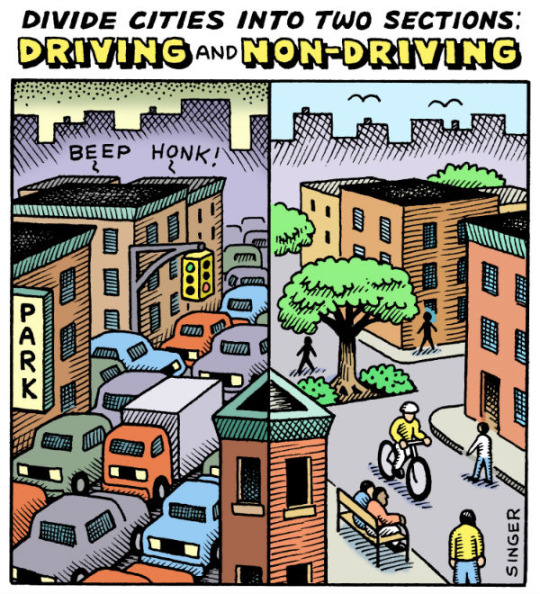
How did you become interested in issues of sustainability, transportation, and auto culture?
I had a moment in high school, going to a concert in Nassau County, Long Island. I bought tickets off a scalper, which turned out to be bogus, but the people whom we had driven there with got into the concert. So we spent three hours just trying to amuse ourselves walking around the parking lot [at the Nassau Coliseum]. And it was just this moment of realizing that everywhere you looked there was nothing but concrete and cars. And I think that was the first moment where I realized, wow, there are too many dang cars.
How were you inspired by some of the urban and suburban forms you see around you in St. Paul, where you live now, and other places you’ve made home, including New York and Boston?
I’ve just noticed in different places that I’ve lived that people like to visit old places. When you go to New Orleans, for example, people want to see the French Quarter, the older parts of it. Or when people are in Boston they want to walk the Freedom Trail and see Paul Revere's House and Beacon Hill and the old parts of Boston. There are historical reasons for that because they want to see the history behind something. But I think that people also like those spaces, and they like those spaces in part because they're walkable.
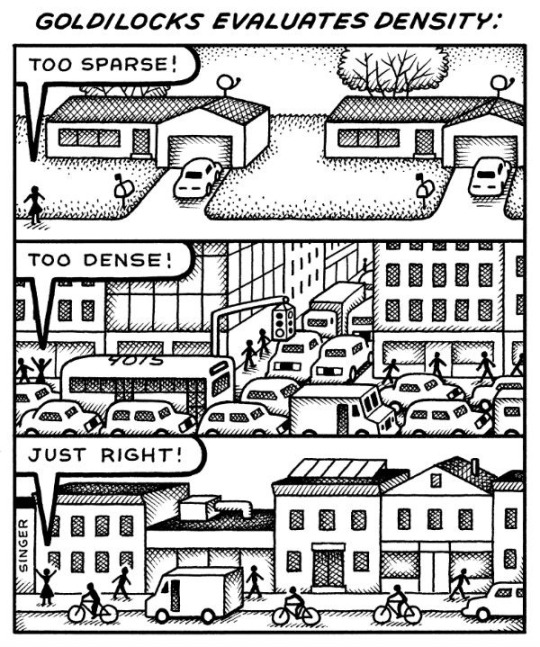
The first cartoon in the book — across from the title page — shows the 'Goldilocks' version of mixed use development. How did you come up with this idea, and how does it map onto how you view the discussions about density and urban development?
Another peeve I have is that there is pretty much a common awareness among people in New Urbanist circles that low-density sprawl, car-oriented sprawl is a bad thing — environmentally, socially, economically, etc. But there's also this non-agreement as far as how much density is too dense.
And there's this idea that we can have hyper-density that is somehow much more environmentally efficient than this low-density sprawl. I think that it could well be more efficient than low-density sprawl, but is it the most efficient level of density?
And you see when there’s a power blackout, in a lot of these hyper-dense cities, a lot of these buildings become uninhabitable because they require electric elevators and water pumps and all sorts of mechanical stuff to make them usable. You're not going to be able to get up to the 25th floor of your building and back down on a regular basis. And they require much more energy-intensive materials to build and to take down than, say, a three or four-story walk-up.
You write that you are "an advocate of car-free cities, car-free city sections and car-free living." How do your drawings try to illustrate how people should think about these possibilities?

I’m trying to encourage people to look at the pre-automotive sections of their own cities as a guide or an envisioning of what their city, or sections of their city, could look like without cars, at what life would be like without cars. I think a lot of times when you see something or you envision something, you understand it more. A lot of people see a freeway, for example, in the Twin Cities, and they think that that freeway has always been here. And maybe for their entire lifetime it's always been there. But they don’t realize that, wow, there used to be townhouses and apartment buildings and homes on that land before that freeway was put in, and people lived in a very different way 100 years ago.
Any last words?
If there’s a takeaway that I want people to have, for lay people or people who are not steeped in all this, it is to appreciate some of the ways that automobiles impact our landscape and impact our lives and our environment and economy.
But I think for people who are more into these issues, I want people to think about the tax structures, the way that in almost every state we have all of our motor vehicle fees and gas taxes being dedicated to highways. This tends to cause states to choose highway solutions to transportation problems, even when another solution using transit or better land use would be more appropriate. There are systemic forces that tend to drive highway building.


These "before and after drawings" represent Singer's visions of the different kinds of land development and sprawl that accompany rail vs. highway infrastructure.
Cars revolutionized transportation, but when we started to design cities first-and-foremost for cars, we put other travelers’ safety at risk, and even made it impossible or impractical to get around any other way. There are people who can’t easily travel except by car, so I’m not all about eliminating cars, but rather dramatically reducing their use.
Some of the ways we can do that is by eliminating government-mandating parking minimums, and legalizing “mixed-use” zoning, and “missing-middle” density. The most comfortable, livable, pedestrian-friendly cities in the world are mostly mid-rise.
70 notes
·
View notes
Link
For 63-year old U.S. Post Office carrier Peggy Frank, that Friday marked her first day back at work after recovering from a broken ankle. At 3:35 p.m., Frank was pronounced dead after paramedics found her unresponsive in her non-air-conditioned truck. In September, the Los Angeles County coroner’s office confirmed what seemed a forgone conclusion: Frank died of hyperthermia — she overheated.
A few months later, in November, the Woolsey Fire swept through Malibu and parts of the San Fernando Valley. The blaze killed three and forced the evacuation of almost 300,000 people, burning 96,000 acres and destroying 1,643 structures. Then, after heavy rain in areas scarred by the fire, came the mudslides in December and January that killed one person and closed portions of the Pacific Coast Highway.
For most of the population, climate change is too big a thing to grapple with. As the theorist Timothy Morton argued, it’s a “hyperobject” — it is too big, too sprawling in time and space, and too complex to see fully from any single vantage point. It’s numbing. But by narrowing our focus, we can catch more than a glimpse. It may be easier to understand climate change at the regional level, says Katherine Davis Reich, associate director of UCLA’s Center for Climate Science. “We can all appreciate what climate change impacts would be in our backyard and act on that, much more than at the global level.”
Los Angeles, the second-largest city in the United States, is perched precariously on the edge of the Pacific. Not long ago, it was the nation’s frontier; today, its cultural industries produce the globe’s films, music, and television, always hunting for the next new thing. Here, the line between the present and the future has always been thin. As it swelters, burns, erodes, and collapses, that barrier may have been swept away altogether. For L.A., 2018 was not a sign of things to come. It’s a sign of things that have arrived.
That Los Angeles should exist at all is itself a tale of the extraordinary becoming commonplace. An underpopulated backwater until the discovery of oil in 1892, today’s L.A. is a thick smear of civilization over what may not actually be a desert, but what certainly has the mythic feel of one. Precariousness is the resting state of L.A.’s collective unconsciousness.
The city has been grappling with ecological collapse since its beginnings — and not just in films like Chinatown or San Andreas. In 1927, the Los Angeles Times warned of an environmental reckoning: “I was pessimistic enough to imagine that self-confident Los Angeles had forgotten Babylon, Palmyra, Palestine, China and Timgad. What I now saw was our own beloved land. And I saw sand dunes, sage brush, aridity, stately ruins, idle derricks, desolation.”
“By the end of century, a distinctly new regional climate state emerges.” This climate includes a new, fifth season: a super summer.
Even the most dire predictions don’t suggest that Los Angeles will go the way of Timgad — a Roman colony in modern-day Algeria that is now covered by sand. People will still flock here, and even if the city were to collapse, it would happen over a much longer time scale. Still, by 2069, Los Angeles could well be on the way to a new season of misery.
“With the exception of the highest elevations and a narrow swath very near the coast, where the increases are confined to a few days, land locations see 60–90 additional extremely hot days per year by the end of century,” one study concluded. Downtown Los Angeles could experience up to 54 days measuring 95 degrees or higher by 2100, a ninefold jump. By then, temperatures in Riverside could reach over 95 degrees for half the year.
“By the end of century,” the authors of the study found, “a distinctly new regional climate state emerges.” This climate includes a new, fifth season: a super summer, driving people indoors for weeks at a time, stressing the power grid with heavy demand for air conditioning, and wreaking havoc on agriculture and, by extension, the food supply.
Climate change plays favorites, and the heat increase would not be evenly felt. In fact, its unequal distribution could create an “environmental justice story,” explains Davis Reich. “Areas like the San Fernando, the San Gabriel Valley, or the Inland Empire, where the extreme heat burden is already greater, are where the season of extreme heat will occur — parts of the region that are arguably less well-equipped to deal with compared to places like Santa Monica.” There’s a dark irony there, since wealthier people produce more carbon emissions. “The people who have contributed to the problem the least are going to suffer from it earlier and more,” Davis Reich says.
Meanwhile, beaches in Los Angeles will be facing their own threats. Rising sea levels will attack the coast in at least two ways: inundating beaches and eroding cliffs. “Our beaches are compromised. Not just from overall sea level rise, but also coastal storm events,” says Lauren O’Connor Faber, the city’s chief sustainability officer.
In 2017, scientists modeled the effects of sea level rise on 500 kilometers of shoreline in Southern California. A sea level rise of 0.93 to two meters, they predicted, would result in the loss of 31 to 67 percent of beaches in Southern California, including some of its most well-known. A separate USC studyconcluded, “In Malibu, both low and high sea level rise scenarios suggest that long segments of beach will essentially disappear by 2030.”
“Those beaches are the basis for a lot of California’s identity,” said the first study’s lead author, Sean Vitousek, an assistant professor of civil and materials engineering at the University of Illinois at Chicago.
Vitousek was part of another research project predicting that because of rising sea levels, sea cliffs in Southern California would erode, on average, up to 120 feet over the next 80 years. By comparison, the rate of cliff erosion in California over the past 80 years maxed out at 1.5 feet. At the end of the century, the model predicted an increase in cliff erosion of “27–185% above historically observed retreat rates.”
Those changes put more than just surfers and beachcombers in peril. In 2060, sea level rise will likely put between 414 and 3,979 homes along the coast in the L.A. region at risk of flooding — up to $3 billion in value. Beach nourishment — artificially adding sand to bulk out the shoreline — is one option but may not be enough. The coast could be armored with sea walls, cliffs shored up, and sea gates constructed. Vitousek says that a shoreline retreat strategy might be needed — but it won’t be easy. “Because there is so much money involved in all of this, people will fight tooth and nail to keep themselves on the coast for as long as possible,” he says.
And as the coastline advances, the forests around Los Angeles have already begun to burn.
In December 2017, a series of 27 wildfires ignited in Southern California, including the Thomas Fire, which burned more than 281,000 acres across Ventura and Santa Barbara counties, resulting in two deaths and the evacuation of more than 200,000 people. Less than a year later, the Woolsey Fire burned 96,949 acres, spreading south from the mountains into Malibu, where it destroyed hundreds of homes and killed three people.
If you think think of 1994’s Northridge earthquake as L.A.’s signature disaster, the coming decades may make you reconsider. Because while climate change may not have much effect on earthquakes, it will lead to more — and more destructive — wildfires. The area burned by Santa Ana fires is predicted to increase by 64 percent by the middle of the century, compared to 1981 to 2000, while non–Santa Ana fires, which occur from June to September and are concentrated inland, will increase by 77 percent. The number of structures destroyed will rise as well — 20 percent for Santa Ana fires and 74 percent for non–Santa Ana fires. Santa Ana fires currently threaten 3,400 structures in an average year, while non–Santa Ana fires put 440 structures at risk per year.
Eventually, all that risk adds up.
“One thing that often gets lost is that wildfires are perfectly natural,” Davis Reich says. “These landscapes were made to burn and need to burn periodically to be healthy. When we build into our wildlands, there is a risk that our buildings will burn. We have to confront that more seriously than we have in the past.”
After fires destroyed a neighborhood in the Bay Area in 2017, local politicians debated the wisdom of rebuilding homes in high-risk areas. There was little appetite for such a move there (or for similar efforts in parts of Southern California), but eventually it may become too expensive to continue rebuilding in high-risk spaces. The Los Angeles Times mapped the 1.1 million buildings in California located in zones at highest risk for fires, showing clusters in the Santa Monica Mountains, the Palos Verde Peninsula, Mission Viejo, and Yorba Linda. Nearly all of Topanga, Paradise, and Malibu were also at risk. Few political leaders want to discuss managed retreat yet — but in 50 years, they may have to.
Climate change is no longer on the horizon. It has arrived.
The masterstroke that allowed Los Angeles to grow may be the one that causes it to retract: Los Angeles depends on imported water, whether from the Owens Valley or farther abroad. As the globe warms, those supplies will dwindle and become harder to manage. Sixty to 70 percent of the water used in Southern California comes from the San Joaquin River and Tulare Lake basins, the Sacramento River basin, Mono Lake, and the Colorado River basin. (The bulk of the remainder is pumped local groundwater.) Of that, 75 percent is drawn from spring snowmelt from the Rockies, the Sierra Nevada, and other mountain ranges.
The Fourth National Climate Assessment, released in November 2018, projected “substantial reductions in snowpack, less snow and more rain, shorter snowfall seasons, earlier runoff, and warmer late-season stream temperatures.” Snowpack reduction in Southern California mountains could reach as high as 50 percent by the end of the century. At the same time, water flow in the Colorado River could be down 35 to 55 percent.
Water demand in 2050 is projected at 1.4 million to 1.7 million acre-feet per year, while supply is projected at 1.4 million acre-feet per year. At best, it’s break even. At worst — well, ask Cape Town.
And those estimates may underrepresent the risk to L.A.’s water supply. A 2015 study concluded that “the mean state of drought in the late 21st century over the Central Plains and Southwest will likely exceed even the most severe megadrought periods of the Medieval era,” causing “an unprecedented fundamental climate shift with respect to the last millennium.”
Another study conducted in 2016 found “a pronounced increase of droughts and aridity in the Southwest during the latter half of the 21st century.” A megadrought — one that would last multiple decades — “could become commonplace.” Droughts of that magnitude were associated with collapse of the Angkor, Anasazi, and Maya civilizations.
“There are two futures in front of us,” says O’Connor Faber, CSO of Los Angeles. “One in which we do not act, do not take leadership. We let the disasters happen. That’s an untenable future. The good news is that’s not at all the future that L.A. accepts.”
It’s not a future that the state of California hopes will come to pass. In 2006, the state enacted a cap-and-trade system to reduce its carbon emissions. A new state law mandates that by 2045, California will rely solely on clean electricity. In recent sessions, state legislators have begun to reshape the laws that govern the state’s housing market, hoping to encourage denser buildings oriented around mass transit, rather than sprawl that forces drivers onto jammed freeways.
For its part, the city of Los Angeles has embarked on an ambitious effort to do what it can. As Mayor Eric Garcetti told Rolling Stone in September, “We’re not waiting for Washington. The cavalry isn’t coming.”
So the city is building up local water supplies and curbing demand, increasing the tree canopy and building out cooler infrastructure to reduce its heat island, spurring the installation of solar power, and armoring its beaches and the ports of Los Angeles and Long Beach. Progress has already been made: Emissions at the port have dropped by double digits, tens of thousands of electric vehicle chargers have been installed, and improvements in public transit are coming.
As she works through the list, Faber O’Connor says she recognizes the magnitude of the task but has reason to hope. “I’m feeling very positive,” she says. For her city, climate change is no longer on the horizon. It has arrived. And like a car speeding down a clear freeway, the city is racing to catch up.
Phroyd
23 notes
·
View notes
Text
Review: Conan Exiles
Quick disclaimer; I’ve only played single player with some interest in coop. I’ve yet to attempt open servers. As a result, I probably haven’t run into the more annoying stock of communities like purges and raids. I’ve played alone, modded, and at my own speed; that may color how I see this game. I’m okay with this.
Let’s talk about Skyrim for a moment. Yes, it’s relevant. Do you all remember the first five to ten hours you played it? You were still weak, dealing with iron and steel swords and slashing your way through new caverns and dungeons while scrounging every bit of material you could for your smithing skill. Everything was new and different, and every new playthrough with a different race or weapon type.
Then something happens. Several hours in, your smithing and sneak is 75+, you’re level 40 on Expert Difficulty one-shotting every bandit in every dungeon because you took a couple of very specific perks that make the entire game a cakewalk. Or you used alchemy to hilariously boost your stats in the several hundreds or thousands and now your armor rating is at a complete maximum and you’re doing sixty times melee damage on sneak attacks.
At a certain point, Skyrim gameplay becomes less about mechanics and just about exploration.
However, Exiles basically takes those first few hours and expands them across the entire experience. I get a bit of a Skyrim meets ARK and a lesser used comparison is that I’m honestly getting an Assassin’s Creed: Origins vibe, if nothing else certainly the aesthetics. Large sandy dunes and mountains with spotty greenery and oases, and I’m pretty sure I have an identical screenshot of climbing up a red mountain. My exile and Bayek would probably get along.

For whatever reason, I find Exiles to be a bit more accessible than ARK ever was. I think it’s perhaps the single player admin menu which if ARK has I have never found. Through it you’re able to manipulate things to an insane degree, like ten times the amount of experience and resource gain, as well as modifying how much damage you do and enemies take. I went through a largely unaffected run (though I did bump my experience up to 2X) the first time around and that sucked me in for several hours. In future games, I made it a little easier on myself with quality of life workshop mods including upping armor durability and reducing boss health pools. That last one might sound like a cheat, but when they have up to 30,000 health and I’m alone in the world, lowering it down to 10,000 or something makes the experience a LOT more bearable. I’m not saying ARK does not have these features (it does have workshop support) but it just wasn’t nearly as compelling as Exiles, which does in fact have a story contrary to what some reviews claim.
You start the game creating your character and get a randomized set of “crimes” which can include anything from punching a camel to lewd acts with corpses. It ranged wildly and there’s quite a list that can be quite comical, though the game itself is largely void of humor. Conan himself shows up to remove you from the cross and the game dumps you in a desert road, entirely naked and scrounging for fibers, rocks, and branches; all the things you’ll need to quickly craft a set of clothes and basic tools.
The story doesn’t really hold your hand, nor does it tell you what to do. There are runestones dotted around the land that give you snippets and clues. The idea is that you have a magical slave bracelet that’s holding you in what is literally called “The Exiled Lands”, which is the whole area of the map you’re in. Go too far, and you’ll find a green shield that will automatically kill you. What’s involved in this is finding a large variety of bosses and McGuffins that will eventually remove the curse of the bracelet and allow your exile to leave.
That’s the basis of your presence in this strange world. What happens after that point is really up to you. Since you can hardly take on an undead dragon right out of the gate, you pretty much engage in the usual ARK/Minecraft flare. Build a house, hunt animals for hide, and generally spend a lot of time working your way up.
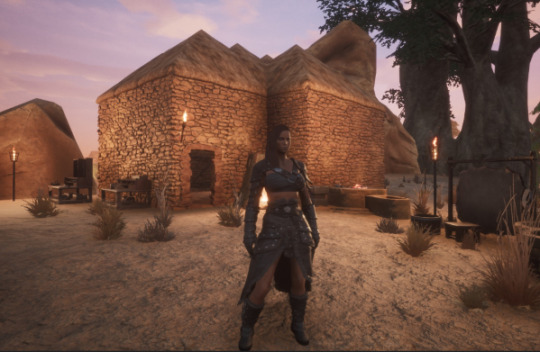
Eventually I found that I had the most fun when I had a decent set of medium armor and a good stock of weapons that I could repair on the fly and that allowed me to make various expeditions outside the comfort zone of what people call the “newbie river”, the southern-most landscape that offer you the most resources within a reasonable travel time. I eventually made it to the Hinterlands where I was able to harvest heavier leathers for better armors, which in turn allowed me to travel farther and take on more intimidating enemies.
As you’d expect, you have to manage some resources including hunger, thirst, heat and weight. Thirst can be fairly easy to manage if you’re hanging around the southern portions of the map. Hunger isn’t too bad, and weight I’ve modded out entirely, which I’ll justify shortly. Beyond that there’s a full listing of RPG elements with various perks and stats you can acquire as you level up. In an unmodded game you can only max out a couple so in multiplayer or co-op games you may want to split roles between survivors, gatherers, and combatants.
The most fun I’ve had in this game is just the unrestrained exploring, which for me has only been with the help of some workshop mods. I got an insane encumbrance mod early in my career because once I acquired a legit “decent” set of armor, my weight was at 70% regardless of how much stuff I tried to store away. Even in my most purist playthroughs, that mod will always remain. I am less irritated with weight in the likes of Skyrim because I typically have fast travel and stores to sell my crap to, but here I do not have that convenience. Fast travel in Exiles is possible but more of a mid- to end-game perk once you explore enough of the map. There’s a bunch of obelisks you can purify and then travel to through a map room, of which I haven’t done a lot of research and I’m not sure where to find that. As it stands, everything you need you have to get on foot. No horses, no mounts, just hauling all the ass.

The lack of fast travel is indeed a late-game annoyance. Alongside that are a variety of bugs that you’ll come across for a post Early-Access game. I’ve found that engaging in combat within certain variables will have me and the NPC I’m fighting just... sorta flail at each other for a bit. Neither of us take damage, and I noticed that it is because we had some buildings and terrain above us. I lured them out and now we both took damage again.
Speaking of, the combat leaves a lot to be desired. It gives me Origins vibes again with some blocking, dodging and health bars. However there’s absolutely no lock-on and hit detection is very wonky when I try to do some light attacks right next to a crocodile only for them to miss entirely. I had to back up and try again and it would work. This happens about twenty percent of the time, depending on my attack. Conversely, a heavy spear attack always hits my enemy.

Some enemies also have knockback effects. I’d be fighting basic bird type enemies and they’d reel in, walk towards me and I’d be knocked over. Apparently they’re “charging” but they don’t go faster than walk speed and thus are difficult to detect. Maybe that’s my fault but it’s just a bit annoying.
I also find base building to be vaguely irritating and I find myself doing the ol’ Fallout 4 thing of turning on god mode (in this game, admin mode), getting unlimited resources and at least starting with the basic shape of the building that I want. I’ve only resorted to that once in my ~5 playthroughs and my next semi-purist play will try to be a little more conservative and patient.
Patience is really the key here if you want to get the most out of the game. I’ve tried rushing towards the revered “Star Metal” for the endgame gear but found myself perfectly content with some normally crafted heavy stuff, or light armor if I want to dodge enemies more often. Exiles is kind of a slow burn at first but once you find an established area with decent walking distance to most forms of resource, you’re probably in good shape. My experience shined when I was in expedition mode, treating every corner as a new experience. Maybe in a few hundred hours nothing in this game will be new to me, but for now all I can do is stare wide-eyed at the world before me.
3 notes
·
View notes
Text
Time and Again
When Bart Allen crash lands in the present, it’s strange, and he’s strange, but Danny has long been used to strange. He bobs his head when the YJ team relates to him what Bart had said about the future; his eyes closing when the knot in his chest releases at the telling of Impulse’s future. He’s not a monster.
Bart screams the first time that he sees Phantom.
Dan glances up at the natural portal over his head, double checking that it was indeed still open, the Infi-map thrumming in his belt. He turns his gaze back to the workers laboring away.
Blue looks up at him, squinting into the empty space created by invisibility. Dan knows well enough now that the Reach suit can read the ecto-magnetic signature of his core. That had been established decades ago. The psionic cannon whirs, and Dan grins, flickering into view; red eyes dancing with mirth and revenge.
Dan’s howl neutralizes the blast; the air vibrates with the tension of conflicting sound waves.
Small things here and there trip Bart up. A comment here, a sidelong glance, stiffening abruptly when Phantom phases through the wall, staring a little too long at Danny (both human and ghost) as if he’s trying to catalog the differences. Danny’s skin prickles and flashes of the desolated landscape from his future echo.
He relates these to Tucker and Sam; they vaguely remember the incident through a fog, but they nod and write down the instances that Danny lists. The journal confirms Danny’s suspicions that Bart is lying about his role in the future.
An electric blast from Black Beetle illuminates Dan’s frame, highlighting the glowing scar that sit across his chest, slipping across his collarbones and bisecting the insignia. Dan remembers dying; he remembers the pain and distress at watching GIW and Reach scientists alike poke and prod. He remembered his human side violently rejecting him, barring him control while it slipped out of the black hazmat and into civilian clothes to bleed out and find rest. Phantom, the halfa now dead, remembered their names and faces.
He didn’t kill them. He just worked to be a constant nuisance, a thorn in their side. He was angry, yes, but he refused to become that creature from his nightmares. It was a line he’d drawn. Helping out the workers made him feel better, overshadowing them to share his strength and let them rest for a moment.
That was how he’d found Vlad, actually. The older halfa had been doing much the same. Plasmius’s eyes had echoed the loneliness Phantom felt inside as they discussed how he’d come to be captured, how the Reach tech had learned to corrupt both Valerie and Jazz’s suits. The discussed the era of the fallen heroes. It was nice to reminisce even if those memories were tainted with anger and revulsion from how those heroes had been vanquished. Plasmius asks after the specifics, and Phantom state–as a distraught Vlad had told him in a future so many years ago–that some things are better left unsaid.
Time ticks on. Both are acutely aware of Clockwork’s radio silence.Vlad ceases to aide as Plasmuis now that the Reach follows him everywhere. Apparently, they finally deemed Luthor’s files worth a read. Vlad has not been a young man for years, and now Phantom helps as he does with the laborers, sometimes overshadowing Vlad through the worst of it. He works carefully to avoid expelling him as Point Dexter did so many, many adventures ago (was that even him? it couldn’t have been).
Dan remembers dying then too, the feel and slide of Vlad’s body tiring, how it felt to lose that last vestige of humanness and how the collapse into a single wavelength of their two separate ghostly cores rippled across their (his?) being. He remembered how the grief and loss resonated through and that spark of defiance and vengeance hollowly drove at him.
Dan Plasmius was a ghost that killed. He razed the testing labs, freeing as many of the Metas as possible, but ultimately, he wasn’t willing to sacrifice his existence. Dying twice (4 times technically including the accidents) does that to you. There was a speedster there; Dan swallowed down the nostalgia that came from that.
Bart evades Danny like it’s his job.
Danny hunts him down like he’s freaking Skulker or something. Probably more like Walker honestly. He has to know though. He has too!
He can’t go into this fight not knowing if at any second he’s going to trigger his change into Dan Phantom. Danny can’t go through that again with this family.
Clockwork’s intervention isn’t what he’d expected. Be drastic. Be bold. Be enough of a ‘rival’ bad guy to create a scientific time travel back.
Blatant support to misuse the rule of the Ghost Zone? Granted. Dan doesn’t atriculate the unease in his core as he reestablishes himself as ruler of the ghost zone. His memories as Plasmius call this hollow, but Dan shrugs his discomfort off and works at it. The Phantom memories balk at being trusted with so much power and responsibility, and Dan soothes that away with a reminder that they’re not 14 anymore, that they have experience and know the risks and rewards.
Being a hero is hard. Knowing that this is the best way is even harder.
Under new management. That’s your threat. You challenge and harass the Beetles and the Reach. You talk up how much better the Ghost Zone is doing (which it is). You make sure that the laborers (slaves, Plasmius corrects) can always see your confrontations. You thrum in sympathy because you know that you’re making their lives harder. You know that you have the potential to start an apocalypse, but that’s not who you are.
You don’t care anymore how the people see you; you’re too focused on fighting the Reach. You overshadow Blue Beetle and Jaime’s psyche welcomes you with shock and relief and so many emotions that you can’t even comprehend them.
The scarab changes its electrical signal shortly after and Dan Plasmius is thrown away. There’s a speedster that watches this, and Dan aches in pity of his former teammate. He doesn’t leave the Ghost Zone again.
Getting Bart to talk legitimately takes a trip to Clockwork. Danny taps his fingers while Bart makes his feet thrum on the floor. Clockwork’s been ignoring them, flitting through his castle and choosing to do other things instead. Danny jumps when on one of the passes, the time ghost sets a dented (still sealed, thank god still sealed) thermos on a table just beside them.
“We’ve been expecting you.”
Dan Plasmius glances around (between the younger half him and the speedster, between clockwork and the sealed thermos, and all around).
“I guess I owe you an explanation,” he directs to the ginger, “Surely, you’ve figured out now, that I’m just 90% talk with the power to back it up.”
101 notes
·
View notes
Text
The Very Best Gadgets We Saw at CES 2020
It’s Saturday, CES is finally done, and over 150,000 people have fled Vegas for less light-saturated locales. We walked the show floor and went to every secret hotel meeting we could to find the best gadgets coming out of CES this year.
These are nearly all products that will be available in 2020—no concept cars or far-fetched robots here.
Lenovo ThinkPad X1 Fold
Photo: Sam Rutherford (Gizmodo)
All first-gen products are a bit awkward, and that goes double for anything featuring a flexible display. Even so, Lenovo’s ThinkPad X1 Fold seems really promising. You can use it in landscape mode with its detachable keyboard like a portable all-in-one, or rotate it 90 degrees, bend it in half, and voila, you have a thick, but still very portable clamshell. And unlike Samsung’s Galaxy Fold, the X1 Fold doesn’t have a crease, with Lenovo even using the gap between its screen as a place to stash its keyboard while traveling. And because the X1 Fold is part of the ThinkPad family, it had to pass the same battery of mil-spec test regular Thinkpads get subjected too, so it shouldn’t be a delicate flower like the Galaxy Fold. But perhaps best of all, is that—unlike Dell’s foldable Concept Duet—Lenovo is going to start selling this thing this spring. Like it or not, the ThinkPad X1 Fold is the start of a new era for laptops. – Sam Rutherford
Suunto 7
Image: Suunto
Wear OS has gotten the short end of the stick when it comes to smartwatch operating systems. That’s why it’s notable that Suunto, which is known for its in-depth performance metrics and GPS maps, has picked it for its platform. The Suunto 7 is the company’s first true smartwatch, and even though it’s a big boy, it’s not hideous and is incredibly light on the wrist. When you consider it comes with offline, downloadable maps, NFC payments, Google Assistant, over 80 sports profiles, and around two days of battery life (pretty good for a Wear OS watch), it’s definitely one of the more exciting wearables at the show. — Victoria Song
Quibi
Gif: Quibi
I still have no idea who will actually subscribe to Quibi, the new phone-only streaming service from the guy who brought you Dreamworks. But there are a lot of talented people making content for Quibi, and it’s the rare streaming service that’s still studio agnostic—with content planned from Disney even! But what’s really cool is the way it serves up two different films with the same soundtrack. You decide the experience you get all by the orientation of your phone. — Alex Cranz
TCL 6-Series of 2020
The cheap 4K TV keeps getting better. Not only is the 2020 TCL 6-Series outfitted with future-forward ports like HDMI eARC. It’s also getting new backlighting with mini LED technology. This means that, whereas last year’s model had 100 local dimming zones, the new model will potentially have thousands, which should greatly improve contrast and viewing angles. In other words, this upgrade could bring the picture quality closer to that of an OLED TV for a fraction of the price. — Adam Clark Estes
L’Oreal Perso
L’Oreal has consistently brought interesting skincare tech to CES year after year, and the Perso is no exception. It’s an attractive device that manages to blend together AI, augmented reality, and environmental data to create a personalized skincare regimen. The hardware is also impressive, featuring special motors that work with NFC-enabled cartridges to dispense the precise amount of product. Perso can also be used to create custom lipstick colors and foundation. The design is also thoughtful in that the top detaches, so whatever you create can be carried along with you for the rest of the day. While Perso won’t launch until next year, it could easily be a device that not only reduces trial-and-error but could also save money and declutter your bathroom. — Victoria Song
E Ink Color Paper
It feels as though electronic paper has evolved at a glacial pace compared to other display technologies like LCDs and OLEDs. Since Sony’s original Sony Librie came out 16 years ago, e-paper has remained black and white, with only marginal improvements made to its contrast and resolution. E Ink started demonstrating its first full-color electronic paper displays at CES a few years ago, but for 2020 it’s managed to solve issues with agonizingly slow refresh rates. It now takes E Ink’s colored electronic paper less than two seconds to load an entirely new image, which paves the way for its use in e-book readers like Amazon’s Kindle. Color reproduction is limited to around 40,000 shades, but the advantages of E Ink technology are still there, including easy visibility in sunlight, and incredible battery life. — Andrew Liszweski
Impossible Pork
We can’t believe it’s not pork! This year, Impossible Foods introduced a plant-based pork substitute that blew us away in a taste test. The texture, cook time, and flavor are spot-on, and frankly, we couldn’t tell the difference between Impossible pork shumai and the real thing. It’ll be available in select Burger Kings later this month. We’re not entirely sure when it’ll hit restaurants or grocery stores on a larger scale, but we can’t wait to stuff our faces. — Victoria Song
Samsung Galaxy Chromebook
Chromebooks are pretty simple devices, there’s no need for a ton of gimmicks or shouty features. So on Samsung’s first-ever Galaxy-branded Chromebook, Samsung didn’t mess with the formula and instead just made sure that every single spec and component was really high quality. Sure, starting at $1,000, it’s kind of expensive, but when you consider that the Galaxy Chromebook has a 4K AMOLED screen with HDR certification, stylus support, an Intel i5 CPU, and up to a 1TB SSD, the Galaxy Chromebook still manages to feel like a deal. And with a super-thin aluminum chassis and a beautiful red paint job (the gray one is fine too), the Galaxy Chromebooks are some of the prettiest laptops we’ve seen in years. — Sam Rutherford
Jabra Elite Active 75t
Image: Jabra
The Jabra Elite 75t released last fall stood out as a potential AirPod Pro killer thanks to their killer performance and great sound. Now, the Danish audio company has improved on that design with a new ultra-waterproof and durable version designed for sports: the Elite Active 75t. The new truly wireless earbuds feature an IP57 rating, which means they’re submersible in up to a meter of water for 30 minutes, as well as a soft-touch coating that makes them easier to handle with sweaty palms. They also get 7.5 hours of battery life on a single charge, and they’re still cheaper than AirPods Pro! — Adam Clark Estes
Linksys Wellness Pods
By monitoring signal disruptions in your home’s wifi, Linksys Aware turns your wireless network into a home security system that doesn’t require any additional hardware to install. At launch the feature was limited, simply alerting homeowners to the presence of potential intruders while they were away, but in 2020 Linksys will be expanding what Aware is capable of through optional Wellness Pods that increase the feature’s sensitivity, allowing it to detect someone having a restless sleep based on subtle movements and even their breathing rate. The Pods will also allow Linksys Aware to detect and react to someone falling, such as an elderly relative, triggering an emergency response which includes contacting help and even reassuring them through a smart assistant like Amazon’s Alexa. — Andrew Liszewski
Stern Stranger Things Pinball Machine
Gif: Stern
Pinball machines haven’t seen a lot of big changes over the years. They’re still primarily just balls flying across a stretch of smooth material and manipulated with bumpers and springs. But Stern’s new Stranger Things machine really seems to incorporate all kinds of cool and unusual stuff. In particular, magnets that mimic Eleven’s telekinesis and hold balls in place, and a big projector in the center of the play area that seriously catches the eye. — Alex Cranz
The post The Very Best Gadgets We Saw at CES 2020 appeared first on Gadgets To Make Life Easier.
from WordPress https://ift.tt/39sAP1l
via IFTTT
0 notes
Text
The 2030 Last-Minute Christmas Gift Guide
Buying Christmas gifts for you friends, family, and loved ones is always hard—and after yet another turbulent year it looked like maybe it was finally time to just cancel the holidays! But things are finally looking up, and we can’t think of a better reason to celebrate.
With the ceasefires still holding in Texas and Idaho, clean(ish) water restored to almost half of Los Angeles, and—most importantly—Amazon confirming that yes, they will be restarting deliveries to Evac-Bill registered US citizens in most major FEMA Relocation Camps, there’s never been a better time to get in the festive spirit with a little retail therapy!
Whether you’re a Tier 1 high flier with a bonus to blow or an Unranked trying to make that final Freedom Dividends payment last ‘till January, we’ve got gift ideas to match all wallets and payday loan repayment strategies!
Tier 1 Zone Day Pass
From $199/day – restrictions apply, see below
Want to see how the other half lives? Well, I guess more accurately it’s the other 0.1%, but why get hung up on numbers? Grab a Tier 1 Day Pass from Darklake Security for a family member—and maybe one for yourself—and get a chance to explore parts of the city you’re never usually allowed to see! Want to hit the shops in Manhattan’s Hudson Yards? Have brunch under the Park Slope Climate Dome in Brooklyn? Take a stroll and check out the view from Pacific Heights in SF? With a Tier 1 Pass you can walk straight in to dozens of exclusive, restricted neighborhoods in cities around the world, no questions asked!*
Rub shoulders with the brilliant, beautiful, and financially solvent—who knows who you might bump into! And with the special Connect package deal, for just an extra 30 bucks, you can enjoy a whole day of Tier 1 internet access and surf like an influencer—stable connection, fast download speeds, nazi-free social media, data anonymity, and no pop-ups. Come and get a taste for the Tier 1 life—you’ll never look at your credit score again in the same way!
*Restrictions apply: Tier 1 Day Passes are available only to Evac-Bill registered US citizens. No exceptions. Security checks and infection tests must be completed before admittance to Tier 1 neighborhoods. All visitors must consent to wearing a tracking and monitoring device for the entire duration of their visit. Removal of the device, or breaking of any other laws or restrictions, will result in immediate imprisonment under the 2027 Emergency National Cohesion Act as it applies to Private Enforcement Contractors. Darklake Security Industries reserves the right to refuse or cancel entry at any time, without explanation.
B. W. Trump – Only The Hague Can Judge Me
$29.99 from Amazon on vinyl/CD, streaming available only in Tier 1 Certified Access Zones
It’s been a tough couple of years for Lil BazE: abuse and kidnapping allegations, paternity cases, alleged connections to the Jacksonville Separatist Army, and the reports that his father was refusing to let him visit him in prison—but the triple Grammy-winning rapper is back with the long awaited follow up to 2028’s Air Fucks One. And it does not disappoint.
From the drive-by swagger of "Spray It Don't Say It" through the hot under the collar bump n’ grind of "Shorty Put The Ride In Auto" to the emo soul baring of "Alone On The Gulfstream" every track on Only The Hague Can Judge Me is on point. This is the work of an artist at the top of his career, and one whose talents only shine more as the haters try to step up. With the breakout single"Cancel Culture" currently topping the charts on both sides of the 40th Parallel DMZ, it looks like B-dub has already delivered another hip-hop classic.
The Unlimited Dream Company Bespoke Crisis Zone Tours
Packages starting at $1399 per person
Want to get out and see some more of the world in 2031, but know there’s no way you’ll ever be able to afford international air travel again? Well, there’s still a lot of America to see and explore! It’s fair to say our great country has seen some challenging times over the last decade, including shifts in both our political and geographical landscapes, but as a nation we’ve stood up to and embraced the challenges—and what better way to celebrate this new era than going out and experiencing it yourself?
Want to take a low flying helicopter ride over the Texas Refinery District Toxic Exclusion Zone? Try urban scuba deep under what was once the Miami waterfront? Or maybe you want to take a leaf out of your favorite influencer’s book, and get your photo taken on the rim of the crater that was once the Space X test facility? The Unlimited Dream Company can make it happen, with its range of exclusive, customizable tourist trips. You’ll be given full safety training and orientation—including an entry level handgun course for trips in disputed states—and will be accompanied by medical staff*, Darklake certified security agents, and tour guides with unmatched local knowledge.
Prices are not cheap though, so this is definitely a gift idea for those of you firmly ranked as Solvent A-7 and above. Still, UDC also sells a full range of merchandise in its online store—from FEMA approved radiation-detecting temporary tattoos to "My sister visited the Baltimore Dirty Bomb Clean Up Zone and all I got was this lousy t-shirt" shirts. They make for perfect low cost stocking fillers.
*Medical expenses not included in package prices. Participants are expected to have their own health insurance.
Where’s Elon? – Mindfield Games Ltd
$8.99 in the App Store/Google Play
Where did he go? Did he really make it to Mars? Is he hiding out on the dark side of the Moon? Has he really accepted Chinese citizenship? Or is he just chilling in his luxury bunker in New Zealand? Nobody knows for sure, but with this new mobile game from superstar designers Mindfield you can help track down America's greatest traitor! Based on the classic children’s book, Where’s Elon? challenges you to spot the world’s greatest entrepreneur-turned-environmental-criminal across a dozen beautifully illustrated, scrolling crowd scenes. When you see him point him out quick—and be rewarded with the satisfaction of watching a beautifully rendered drone strike! Fun for the whole family.
The InfoWars Flat Earth Atlas
$25.99 from Amazon
Less an informative text and more an exquisite curio, the official InfoWars Flat Earth Atlas, 8th Edition is the perfect gift for that coffee table book enthusiast in your life. Learn about how everything you thought you knew about physics is a lie, and why nobody has ever been permitted to sail to The Edges, through a series of exquisitely painted and painstakingly annotated maps, charts, and illustrations. And with the addition, new to this edition, of QRcodes on every page that auto post content to Facebook with just a single scan, this is the perfect gift for that uncle that always sparks the most interesting family discussions. You might not be a believer, but can you ever really be sure? About anything? Take some time to shrug off the chains of reason and logic this holiday season and experience the buzz of free thinking—before they try and ration that too!
Marvel vs Star Wars VI – The Final Conflict
$39.99 from Amazon/Disney on uBlu-Ray, streaming available only in Tier 1 Certified Access Zones
If the thought of Tony Stark wearing C3-PO’s face as a temporary face mask or the sight of The Hulk behind the controls of the Millennium Falcon doesn't get you excited, can you really even call yourself a movie fan anymore? This holiday sees the release of the final installment of the saga to end all sagas! For real this time! Will our heroes get over their personal differences in time to band together to save the galaxy from the cross dimensional threat of the Thanos-Palpatine Axis? Will Thor, now struck down as a mere mortal, pass his Padawan training and become a Jedi master worthy of the memory of Baby Yoda, tragically slain in the last movie? All these questions will be answered, plus a bunch that never will, in what is definitely, completely certainly, the last chapter in the series.
Plus as a bonus feature for Blu-Ray owners, make use of the exclusive Auteur Algorithms mode. Disney made a machine learning AI watch hours and hours of movies by classic directors whose IP they own—Kubrick, Kurosawa, Scorsese, DuVernay, and Hitchcock to name just a few—so that it can re-edit and re-frame the movie in their unique personal styles, in realtime. With every watch it will look unique! The long-awaited future of cinema is finally here.
Balenciaga Bug Out Bag
$799, Nordstrom exclusive
If the last ten years have taught us anything, it’s that we all need to be ready to move out at just a minutes notice. We’ve all got—or should have—a bug out bag ready to go, and while being constantly prepared can cause considerable stress and anxiety, there’s no reason that you can’t look stylish! The Balenciaga Bug Out Bag might be expensive, but it’s guaranteed to make you stand out in any crowd, whether you’re trying to get out of the state or into one of the hastily designated public shelters. Packed full of goodies like San Pellegrino-branded water purification tablets and an exclusive Burberry designed insulation blanket, it’s got all the essentials you need to survive the next evacuation call while still looking tight. Got a keen teenage social justice warrior in the family? Then the special Pro Protest edition is perfect for them—with extras such as a Nike branded breathing mask (tear gas rated), an Anker mil-grade laser pointer, and a limited-edition facial recognition fooling make up kit from Sephora. Now you can send that adorable little protester out for the night knowing not only will they be safe but they’ll also be the envy of all their friends as they fight against the oil and tech companies, police brutality, the forced relocation of a local community, or whatever it is the kids get all worked up about these days.
FEMA gift vouchers
$5 – $200, from Amazon and fema.gov
Still don’t know what to get that friend or loved one that’s been relocated to one of the Federal Emergency Management Agency’s temporary residential camps? Then let them pick how they want to treat themselves with a FEMA gift voucher. Not only is it redeemable against certain product lines on Amazon, it can be used in-camp to make their stay a little easier by paying for extra food and water rations, extended shower times, and even little luxuries such as chocolate, fruit juice, and soap. Know somebody staying in one of the Amazon or Walmart co-administered camps? Then get them one of the new Duvet Day passes for just $75, that gets them out of all work camp duties for a full 24 hours!
The 2030 Last-Minute Christmas Gift Guide syndicated from https://triviaqaweb.wordpress.com/feed/
0 notes
Text
Hashed CEO on New Trend In Crypto Startup Investing: Money Wises Up
New Post has been published on https://coinmakers.tech/markets/hashed-ceo-on-new-trend-in-crypto-startup-investing-money-wises-up
Hashed CEO on New Trend In Crypto Startup Investing: Money Wises Up
Blockchain investment is still in its early days. But with a scene that moves fast, it will come as no surprise to hear that the investment landscape has already changed beyond recognition.
Simon Kim, CEO of South Korea-based blockchain accelerator Hashed, says that the days of passive investors handing over cash in exchange for a fistful of tokens are gone.
“Until recently, most blockchain investors haven’t actually contributed to projects,” Kim tells Cryptonews.com/i>. Instead, they have just been stumping up money to initial coin offering (ICO) issuers and watching tokens get sent to exchanges.
“Now they’re wising up,” says Kim. “Investors are realizing that it’s far better to spend time and money on building real products with real value.”
Watch the latest reports by Block TV.
Doing so, he believes, will help discerning investors sort the wheat from the chaff – in a world where everyone and his dog now appears to be making blockchain investments.
Kim says,
“Building gateways for wireless, browsers and payment platforms – there are now a lot of investment opportunities in this area.”
Fast-developing scene
Hashed is a name that crops up frequently in South Korean blockchain news – largely because it is known to be working behind the scenes, backing and advising two of the continent’s largest and most ambitious blockchain projects to date – Link and Klaytn.
The two projects’ operators, Naver and Kakao, are rapidly becoming South Korea’s new tech center of gravity, surpassing even the hardware makers that put South Korea on the global business map.
Naver’s Line affiliate is the most popular chat app in Japan, and enjoys popularity in much of Southeast Asia. And through Line’s Link platform, the company is building a cross-border ecosystem that already comprises dapps, exchanges and tokens.
Kakao, meanwhile, rules the domestic chat app scene supreme and offers a range of e-pay and financial services. Its Klaytn platform has already won some powerful backers, including major international and domestic commercial banks, as well as mobile carriers and hardware makers like LG. Earlier this month, Samsung revealed that its smartphone blockchain wallet would be Klaytn-compatible.
Kakao has recently released details of Klip – a crypto wallet for KakaoTalk that finally joins the dots between its blockchain projects and its lucrative chat app operations. KakaoTalk has some 50 million users – most of them based in South Korea.
As such, Hashed finds itself well-placed, playing a key role with both Link and Klaytn – helping with both funding and leadership.
Kim thinks that one of Hashed’s key advantages is the fact that most of its senior executives (himself included) have a background in developing, rather than conventional finance, a fact that lets the company advise on technical matters – rather than just facilitate cash flows.
Game of blocks
Kim says investors are currently flocking to blockchain gaming – perhaps a natural move considering how powerful gaming companies in East Asia have become. This part of the world, after all, is home to powerhouses like Tencent, Bandai, Nexon and Nintendo, to name but a few.
Blockchain and gaming are natural bedfellows, opines Kim.
“Centralized gaming is problematic,” he says. “The developers own all the assets, so those assets have no real value. It’s like Thanos’ finger snap: They can be wiped out at the drop of a hat. Only blockchain is strong enough to provide a suitable platform for gaming now. If you build a virtual world on top of decentralized foundations, that world will necessarily have more value.”
The company also has a foothold in the North American market, with offices in San Francisco. Half of its accelerator projects are based in the United States.
But there are many who believe that with Europe and the United States tech giants losing their grip at the top, East Asia is the most logical place for a blockchain revolution to begin. Big Japanese companies like Rakuten and SBI have already thrown their lot in with cryptocurrency, and most major banks in the region have already begun commercializing their blockchain operations.
China, which appears to be on the verge of a breakthrough with its digital fiat plans, is also a major blockchain player.
Regulatory roadblocks
But obstacles stand in the way of innovation in all three nations.
Japan’s crypto scene is arguably the most highly regulated in the world – with government agencies and lawmakers scrutinizing every move crypto companies make. China’s crypto-crackdown has forced many innovators overseas, with others choosing to work with the government on its own projects. And the ICO ban and restrictions on investment in cryptocurrency companies in place in South Korea have also forced many countries to relocate to Singapore or Hong Kong.
Although Seoul has happily given its blessing to a number of private blockchain projects, including local authority-run stablecoins, the central government still balks at public blockchain projects – and anything that smells too strongly of cryptocurrency.
Kim, though, is undaunted. He believes South Korea is a perfect base for blockchain accelerators.
He explains,
“The government’s ICO ban was sudden, and perhaps it came about due to an initial lack of understanding. But I’m confident that attitudes are slowly changing. I sense a real willingness to consider the future of the industry.”
He points to the government’s recent decision to award Busan, the country’s second city,with blockchain regulation-free zone status – although Seoul has already made it clear that Busan will have to put its hopes of allowing regulated ICOs on ice.
Kim says that other factors will help blockchain companies’ cause in his home country. He states, “The blockchain penetration rate and level of understanding about this technology among the general public in South Korea is the highest in the world.”
Regardless, people like Vitalik Buterin, co-founder of Ethereum, have already warned Seoul that it will be “hard” to separate blockchain and cryptocurrency policy.
Kim agrees with Buterin’s sentiment, but believes that attitudes will soften as common sense prevails. He says,
“Private blockchain projects alone don’t showcase the full value of the technology. Bitcoin’s growth owes much to the fact that it’s a public platform. I’m confident about the future of South Korea’s regulatory environment.”
Source: cryptonews.com
0 notes
Text
Boston Mayor Walsh Unveils Plan for Boston’s Waterfront to Protect the City
BOSTON – Boston Mayor Martin J. Walsh has rolled out a comprehensive and transformative vision that will invest in Boston’s waterfront to protect the City’s residents, homes, jobs, and infrastructure against the impacts of rising sea level and climate change.
Announced in his annual speech to the Greater Boston Chamber of Commerce, the Mayor’s plan, “Resilient Boston Harbor,” lays out strategies along Boston’s 47-mile shoreline that will increase access and open space along the waterfront while better protecting the city during a major flooding event.
“We’re not just planning for the next storm we’ll face, we’re planning for the storms the next generation will face,” said Mayor Walsh. “A resilient, climate-ready Boston Harbor presents an opportunity to protect Boston, connect Boston, and enhance Boston, now and for the future. As we enter a new era in our Harbor’s history, Boston can show the world that resilience is not only the ability to survive adversity, but to emerge even stronger than before. That’s the promise of a Resilient Boston.”
Mayor Walsh
Resilient Boston Harbor builds off of Imagine Boston 2030 and uses the City’s Climate Ready Boston 2070 flood maps and coastal resilience neighborhood studies to focus on Boston’s most vulnerable flood pathways. The strategies laid out in the plan include elevated landscapes, enhanced waterfront parks, flood resilient buildings, and revitalized and increased connections and access to the waterfront. The strategies will require collaboration and funding between federal, state, private, philanthropic and nonprofit partners.
East Boston, Charlestown:
Based on early recommendations from the City’s Climate Ready Charlestown and Climate Ready East Boston plans, a deployable floodwall system has been installed across the East Boston Greenway, and a section of Main Street in Charlestown is being elevated. Additional measures identified include:
Redesign Constitution Beach to combine flood protection with expanded access and recreation.
Enhance Wood Island and Belle Isle to prevent the loss of the last remaining tidal salt marsh in Boston, while buffering the shoreline from increased waves and surges.
Work with new development projects, including Suffolk Downs, to integrate resiliency measures, increased open space, and community connections.
Elevate transportation corridors like Bennington Street and the East Boston Greenway to create both flood protection and pedestrian connections throughout the neighborhood.
Elevate Main Street as part of the re-design of Rutherford Avenue and Sullivan Square, to block the primary flood pathway through Charlestown. $4.8 million in capital funding has already been committed to the overall project.
Elevate and renovate Ryan Playground.
Redevelop the Schrafft Center waterfront with elevated parks and mixed-use buildings to grow economic opportunity while restoring natural resources.
North End, Downtown:
Flood risks threaten Boston’s financial center, historic waterfront, tourist destinations and residential neighborhoods. The City will launch Climate Ready Downtown to further study the impacts and necessary measures to protect these neighborhoods. Strategies already identified include:
Redesign Christopher Columbus Park and Langone Park and Puopolo Playground to include elevation to protect against flooding while improving waterfront open space and connections to the Rose Kennedy Greenway.
Transform the parking lot at Sargent’s Wharf into a combination of open space and resilient small-scale development.
Elevate sections of the Harborwalk.
Enhance Long Wharf as the gateway for water transportation.
South Boston, Fort Point:
Released today, Climate Ready South Boston identifies the major flood pathways to many of the City’s residential neighborhoods through Fort Point Channel and Moakley Park. In response, the following strategies have been identified:
Create a resilient Moakley Park and a re-envisioned Fort Point Channel to protect homes and businesses in South Boston, the South End, Chinatown, and parts of Dorchester and Roxbury.
Build a coalition of support from the private property owners surrounding Fort Point Channel to assist in creating a signature resilient park system.
Complete the Emerald Necklace from Franklin Park to Moakley Park along Columbia Road to increase access to the waterfront. $11 million will be allocated from sale of the Winthrop Square Garage for this project.
Secure federal support. The City is applying for a $10 million FEMA mitigation grant to begin resilience work along the Fort Point Channel.
The Boston Water & Sewer Commission has begun installing essential infrastructure for reducing flood risk.
An elevated New Ellery Street along the Dorchester Avenue corridor in South Boston, as identified in the BPDA’s PLAN: Dorchester Avenue South Boston to provide additional flood protection for South Boston’s residential neighborhoods.
Complete Martin’s Park, an inclusive waterfront playground that will be climate-ready.
Dorchester Waterfront:
In order to create a resilient, more accessible Dorchester shoreline with increased connectivity, the City will launch Climate Ready Dorchester. Strategies already identified, include:
Re-design Morrissey Boulevard to stop current and future flooding, and open up the waterfront.
Complete the connection of the Neponset River Trail in Mattapan to the Harborwalk from Tenean Beach to Victory Park.
Work with UMass Boston to further open up the waterfront along Columbia Point for the residents of Dorchester.
Work with residents on new and improved amenities for the neighborhood, including better public transit and improved roadway, pedestrian, and bike connections.
Resilient Boston Harbor builds on the investments the City of Boston has made under Mayor Walsh to increase the City’s climate resiliency, including:
Released Climate Ready Boston, an internationally recognized plan that builds on Imagine Boston 2030.
Became one of the first cities to set a target of carbon neutrality by 2050. This week, the City released a Request for Proposals (RFP) for the next update to Boston’s Climate Action Plan that will create a roadmap for that goal.
Expanded open space. Boston ranks first in the nation for resident access to parks.
Making historic investments in green transportation, including protected bicycle lanes in Roxbury, the South End, and North End, and expanded bike share access in Mattapan, Roslindale, and Dorchester.
Completing new resilient design standards for public infrastructure, providing ways for all construction on public rights-of-way to adopt flood protection measures.
The BPDA updated the climate resiliency checklist, requiring new projects to show they are resilient to climate impacts, and is designing a flood resiliency zoning district that will strengthen requirements for new and retrofitted buildings.
Hosting the International Climate Summit in June, where the Mayor led the creation of a new coalition of cities dedicated to buying renewable energy collectively.
Today, Boston is the top-ranked city for energy policy by the American Council for an Energy Efficient Economy, and rating agencies cite Boston’s climate work in support of the City’s triple-A bond ratings.
The projects outlined in Resilient Boston Harbor will require a number of different funding sources. Mayor Walsh announced that the City of Boston will commit 10 percent of all new capital funding to resilience projects. He called on Boston’s state and federal government partners, as well as the private sector and non-profit and philanthropic stakeholders to join the City in committing to make these necessary investments a reality.
The strategy builds on the City of Boston’s Resilience Strategy. Boston’s resilience strategy is focused on ensuring every resident can reach their full potential regardless of their background, and removing the barriers of systemic racism that hinder Bostonians from having access to opportunities.
Stakeholder Statements of Support:
“We have an economic and moral imperative to act on climate change,” said Senator Edward J. Markey. “This requires leaders at all levels of government and our business sector to work collectively to address the challenges facing our communities. As the Co-Chair of the U.S. Senate’s Climate Change Task Force, I am committed to standing with local leaders, like Mayor Walsh, to be the strong federal partner our residents need as the world continues to warm and sea levels rise.”
“Building a resilient city is a serious challenge in response to a sobering threat, but it also brings enormous opportunity to re-think our relationship to the Harbor and create a world-class waterfront,” said Kathy Abbott, President and CEO of Boston Harbor Now. “We commend Mayor Walsh for seizing this moment to design a waterfront that is more accessible, beautiful, and inclusive than ever before. The urgency of climate change requires all of us to step up and work together like never before.”
“Resilient Boston Harbor will not only strengthen the City against the impacts of climate change, it will create a fantastic urban waterfront, opening up many new opportunities to improve public access to the Harbor,” said Bud Ris, Senior Advisor to the Boston Green Ribbon Commission. “Based on all of the analyses that have been done through Climate Ready Boston so far, this is exactly the kind of approach Boston should be taking. We look forward to continuing our partnership with the City to make Resilient Boston Harbor a reality.”
“Given the urgency needed to address climate change, it is exciting to see the City of Boston put forth such a bold vision for the future,” said Rebecca Herst, the Executive Director of the Sustainable Solutions Lab at UMass Boston, “This is a real opportunity to keep Bostonians safe from flooding and invest in our communities. With strong leadership, driven by scientific research, policy analysis and deep community engagement, we can ensure that all Boston residents, not just those with means, are prepared for climate impacts.”
“I want to thank Mayor Walsh for launching Climate Ready Dorchester,” said District 3 City Councilor Frank Baker. “I look forward to participating in that process and encourage my constituents to get engaged and discuss how we can increase access to our beaches while protecting our homes and roads from future flooding.”
“I applaud Mayor Walsh for his continued efforts to make Boston resilient for future generations,” said State Representative Adrian Madaro. “Climate change is one of the greatest challenges facing our City and our planet. The plan announced today will not only protect Boston’s waterfront neighborhoods, but will also improve the quality of life for our residents.”
from boston condos ford realtor https://bostonrealestatetimes.com/boston-mayor-walsh-unveils-plan-for-bostons-waterfront-to-protect-the-city/
0 notes
Text
‘This is how we see the future’
On this brisk January day, it was tough to find parking at the Delaware Department of Transportation headquarters in Dover. Vehicles inched along the rows of cars, everyone hoping for an empty space.
But what if there were fewer cars on the road? What if, instead of parking our cars during an eight-hour workday, we stepped out, and the cars then drove other people around all day long, and a car returned at closing time?
That is Uber’s vision of the future, as explained by Shari Shapiro, head of Public Affairs for Uber in Pennsylvania and Delaware, on Jan. 18 at a crowded meeting of the Delaware Advisory Council on Connected & Autonomous Vehicles.
Uber is a ride-share service operating worldwide that allows people to order and pay for rides through a mobile app. In the near future, the company believes, drivers will be optional.
Surveying the technological landscape, Gov. John Carney created the advisory council last September with Executive Order 14. If connected and autonomous vehicles (CAVs) are becoming more prevalent and could radically transform the world, then he wants Delaware to be ready.
“I would encourage people to consider this as a possibility. When many of us got into it, our immediate reaction was, ‘No way this is going to work,’” said Elayne Starkey, chief security officer for the State of Delaware. Now, she emphasizes education and awareness for this “new, scary and exciting” technology.
Delaware policymakers need to decide how to embrace the technology, and that research has just begun. By this September, the council will recommend strategies to prepare Delaware’s transportation network. They’ll study economic development, technology, privacy, highway safety, infrastructure and more.
The State decides who and what may operate on public roads. Carney had suggested that Delaware could be an early adopter of CAV networks, since the State owns more than 90 percent of all its roads, and DelDOT has improved telecommunications to better monitor traffic. Plus, Delaware can keep an eye on the new technology and create laws to accommodate, or regulate, the CAVs and their drivers.
Testing the waters in Delaware
The general public is slowly becoming more familiar with vehicle automation. Farmers have combines that do much of the work autonomously. New cars have mapping, self-parking and automatic deceleration if they sense a sudden traffic jam ahead. Even airplanes are mostly automated while in the air, except for takeoff and landing.
“In Pittsburgh, at the beginning, seeing an Uber self-driving car was exciting. It is no longer exciting. They are so over it,” Shapiro joked. “We want people to be bored with autonomous vehicles.”
Cars can work at different levels of autonomy, from none to a completely driverless car.
With first-hand experience as a passenger, Jim Lardear of AAA Mid-Atlantic recently rode an automated test shuttle-bus in Las Vegas.
“It was a very smooth ride, I’ll tell you that,” said Lardear, recalling that the “driver” was rated 4.8 of 5 stars.
Maybe autonomous vehicles could fill gaps in the trucking industry, or even Sussex County’s shortage of bus drivers. But that doesn’t mean everyone’s ready to test driverless school buses with real children.
At the same time, could Delaware get a jump on the competition and possibly host a pilot program?
“Delaware has to move fast,” said Cathy Rossi of AAA Mid-Atlantic. “It’s striking a difference between all of those factors.”
The University of Delaware might like to host a controlled test environment at the technology-centered STAR Campus, where students in public administration and mechanical engineering programs could study.
But Uber, Olli and Waymo (a Google spin-off) are already testing vehicles with passengers on public roads, Shapiro said. They want real-life, not practice tracks.
“We need to test on roads where things happen on a regular basis,” with squirrels, construction zones and bicyclists, Shapiro said.
If human error causes 94 percent of car collisions (which it does, according to the National Highway Traffic Safety Administration in 2015), what would happen if humans are removed from the driver seat?
“To date, there have been no crashes as a result of the autonomous driving on these public roads. But there will be. There will be crashes. There will be deaths,” Shapiro said. “But the question that you need to ask yourself is, ‘Will there be less than the 30,000 deaths on the streets that would [typically] happen?’”
Her numbers are modest. The CDC reported 33,736 unintentional motor vehicle traffic deaths in 2014. The National Safety Council had that number at about 40,000 in 2016.
“Why are we doing this? What’s the point? What are we afraid of?” Shapiro prodded. “These are the questions we need to be asking ourselves, beyond, ‘This is a robot car, and that’s scary.’ We have to acknowledge and appreciate that public fear, but what is our job in this room, as far as moving Delaware forward from a technological standpoint?”
Delaware has 400,000 cars registered that are idle 95 percent of the time, Shapiro said. Uber executives believe people would rely less on cars if they could get reliable point-to-point transportation. If fewer people owned individual cars, that could mean fewer parking lots and less emissions.
“This is how we see the future,” Shapiro said.
Riding in real life
Uber itself has been testing autonomous vehicles since 2015, including in San Francisco, Phoenix, Toronto and Pittsburgh.
But they need piles of data before CAVs can be released onto the roadways, even while still attended by a human. First, companies thoroughly map a test city: every road, sign and traffic signal. Cars need that baseline so they can begin looking for things that shouldn’t be in the way: pedestrians, wild deer or double-parked cars.
“If you go on the Uber system in Pittsburgh, you might get an autonomous vehicle,” Shapiro said. “[Passengers] give them the same ratings they give our regular drivers.”
“If you choose to accept, you’ll be picked up by a self-driving vehicle with a vehicle operator in the driver seat to monitor the vehicle as it travels your route,” Uber’s Sarah Abboud later clarified to the Coastal Point.
So it’s not (yet) a completely driverless experience. Having that person in the front seat may help riders feel more conformable with an autonomous vehicle. AAA found that 75 percent of U.S. drivers are afraid to ride in a fully self-driving car, although 59 percent would like to have autonomous features in their next vehicle.
One significant car collision could kill all the momentum of that research, Shapiro said. So it’s self-preservation that pushes companies to design technology right the first time.
They still do regular testing on private courses and on public roads. They’re learning every day, and they could be fully autonomous this year, Shapiro said.
Meanwhile, Uber says automated passenger aircraft are coming sooner than people might think.
In the future, Uber envisions more shared rides, automated vehicles and electric vehicles. That could reduce the stress of driving, especially over long distances. Moreover, DelDOT officials said they see better transportation access coming for elderly and those with disabilities.
But the vehicles bring a truckload of new situations: how police or insurance agents investigate car collisions; how the DMV licenses operators and vehicles; how the State collects and secures data about CAVs and passengers.
Delaware will have to proceed carefully with any promises made with companies it hosts. For example, Pittsburgh’s mayor — who first welcomed Uber with open arms — was later criticized for not getting Uber promises to hire locals or provide free rides “in writing.” States also need to consider the possible loss of traditional jobs, or lost fees, such as parking revenue.
The Advisory Council typically meets on the third Thursday of every month at 11 a.m. at DelDOT headquarters in Dover. Details, including meeting notes, agendas and presentations are online at www.deldot.gov/Programs/autonomous-vehicles.
from Coastal Point - Dollars & Sense http://www.coastalpoint.com/content/%E2%80%98-how-we-see-future%E2%80%99_01_25_2018
0 notes
Link
The following blog post, unless otherwise noted, was written by a member of Gamasutra’s community.
The thoughts and opinions expressed are those of the writer and not Gamasutra or its parent company.
[Video Game Deep Cuts is a weekly newsletter from curator/video game industry veteran Simon Carless, rounding up the best longread & standout articles & videos about games, every weekend. This week's highlights include a GDC talk on 'the aesthetics of cute', the hidden story of TOSE, & the return to car wrecking of key Burnout developers.
Another interesting week of longer-form 'things', and I've been ruminating a bit on how these videos and articles intersect in weird but neat ways with 'breaking news' or 'hottest games'. Seems like you'll get at least _some_ bleed-through - for example, this week we have Battlegrounds, Signal From Tolva & Night In The Woods again, all of which are newish or interesting releases.
But many of these pieces are evergreen & exist separately of the 'hot reactions' grind. Which is good. Exist too close to the 24-hour hype cycle, and you'll miss trends and more thoughtful takes like some of these good folks. VGDC aims to reverse that. We hope you think we do a good job.
- Simon, curator.]
-------------------
Guild Wars 2’s art style passes from father to son (Philippa Warr / RockPaperShotgun)
"Recently I had the chance to talk to ArenaNet (and thus Guild Wars 2) art director Horia Dociu about his work at the studio. One of the interesting things about his promotion to the role is that he succeeds his father, Daniel."
We’ve been missing a big part of game industry’s digital revolution (Kyle Orland / Ars Technica)
"Last year, the Entertainment Software Association's annual "Essential Facts" report suggested that the US game industry generated $16.5 billion in "content" sales annually (excluding hardware and accessories). In this year's report, that number had grown to a whopping $24.5 billion, a nearly 50-percent increase in a span of 12 months. No, video games didn't actually become half again as popular with Americans over the course of 2016. Instead, tracking firm NPD simply updated the way it counts the still-shadowy world of digital game sales."
Warren Spector believes games 'need to be asking bigger questions' (Alex Wawro / Gamasutra)
"Gamasutra sat down with Spector at GDC last month to catch up on how the process is going, roughly a year into his full-time gig at OtherSide. It was an interesting conversation, especially if you're at all interested in where games are at these days, where they came from, and what sorts of stories they're best at telling."
A Rare Look Inside Nintendo (Otaku / Game Escape / YouTube)
"This clip is an excerpt from the French documentary film "Otaku" by director Jean-Jacques Beineix from 1994. It appeared dubbed on German TV some time later, which is the version you are seeing here. It has, to my knowledge, never been released in English. The subtitles are my own. Content is the intellectual property of the original rights holders."
An Interview With One of Those Hackers Screwing With Your 'Black Ops 2' Games(Patrick Klepek / Waypoint)
"He's not there to ruin your stats. He's there to sell you software that'll let you launch a DDOS attack from your Xbox 360. [SIMON'S NOTE: this is crazy - modded Xbox 360s that find other player's IP addresses and can DDOS them?! I had no idea.]"
Put a Face on It: The Aesthetics of Cute (Jenny Jiao Hsia / GDC / YouTube)
"In this 2017 GDC session, Hexecutable's Jenny Jiao Hsia explains why cuteness as an aesthetic may be worth exploring for developers who want to push against current trends in game design."
Proc. Gen. and Pleasant Land | Sir You Are Being Hunted (Robert Seddon / Heterotopias)
"It was a perfect rustic idyll, in its way. Perfectly lovely, nestled between the grassy fields. Perfectly quiet, as only dead places can be. Perfectly still, because a player careless enough to create a disturbance might attract the robotic hunters. Big Robot’s Sir You Are Being Hunted had, through the digital governance of its landscape generation algorithms, somehow perfected the British countryside."
How video games were made - part 3: Marketing and Business (Strafefox / YouTube)
"In this final chapter we cover the business side and marketing of 8 and 16 bit games. [SIMON'S NOTE: Lots of archival footage in here & SO much work cutting it all together - and the other entries in the 'how video games were made' series look pretty good too!]"
Video Games Are Better Without Stories (Ian Bogost / The Atlantic)
"A longstanding dream: Video games will evolve into interactive stories, like the ones that play out fictionally on the Star Trek Holodeck. In this hypothetical future, players could interact with computerized characters as round as those in novels or films, making choices that would influence an ever-evolving plot. [SIMON'S NOTE: lots of responses to this all over the Internet - here's a couple of good ones from the Waypoint folks.]"
'Burnout' Series Creator Talks Remaking Crash Mode for 'Danger Zone' (John Davison / Glixel)
"Spend longer than a few minutes talking with fans of driving games about which series they'd love to see revived, and invariably someone will bring up Criterion's Burnout. Unlike contemporaries that were leaning harder into realism and officially-licensed cars as a response to games like Gran Turismo, the first Burnout – released by Acclaim for PlayStation 2 in 2001 – was unapologetically action-focused."
Famitsu Special Report – The Mystery of TOSE (Famitsu / One Million Power)
"This is the real story behind TOSE: The game development company that’s been making games for nearly 38 years (since 1979), but hardly any gamers know. [SIMON'S NOTE: Brandon Sheffield covered TOSE for Gamasutra back in 2006, but by and large, they've been PRETTY vague about what they work on - which is fascinating.]"
How Three Kids With No Experience Beat Square And Translated Final Fantasy V Into English (Jason Schreier / Kotaku)
"One day in the late 1990s, Myria walked into the Irvine High School computer room and spotted a boy playing Final Fantasy V. There were two unusual things about this. The first was that Final Fantasy V had not actually come out in the United States."
Night in the Woods is Important (HeavyEyed / YouTube)
"An analysis of the recently released game - this video contains very minimal spoilers but watch at your own discretion.."
Designing the giant battle royale maps of Playerunknown's Battlegrounds (Alan Bradley / Gamasutra)
"For Brendan "Playerunknown" Greene, the creator of Battlegrounds, the vision for his game world was born from extensive experience creating and manipulating environments that direct players to play his games the way he intends them to be played."
All We Have Is Words (Matthew Burns / Magical Wasteland)
"Sometimes I give the impression of knowing Japanese, but I really don’t. I have no claim to it. I never made a real study of the language, I don’t know kanji and thus can’t read at all, and even in speech I can’t exchange more than pleasantries or the most rudimentary logistical information. [SIMON'S NOTE: I believe this is a subtle 'subtweet'-style article response to the recent Persona 5 translation furore? Maybe?]"
Changing the Game: What's Next for Anita Sarkeesian (Laura A. Parker / Glixel)
"Anita Sarkeesian’s talk at this year’s Game Developers Conference in San Francisco falls at an unfortunate time: 10am on the last day of the conference – a Friday. Most attendees – a mix of indie programmers, mainstream publishing teams and media – are still bleary eyed from the night before. And yet, at five-to-ten, the small room on the third floor of the Moscone Convention Center is standing-room only."
The quest to crack and preserve vintage Apple II software (Leigh Alexander and Iain Chambers / The Guardian Podcast)
"Why has the quest to hack old Apple II software become the best hope we have of preserving a part of our cultural history? How do these floppy discs – still turning up in their box-loads – shine a light on the educational philosophies of the 80s? And do a new generation of gamers risk losing whole days of their lives by playing these compelling retro games in their browsers?"
Video Games Help Model Brain’s Neurons (Nick Wingfield / New York Times)
"Since November, thousands of people have played the game, “Mozak,” which uses common tricks of the medium — points, leveling up and leader boards that publicly rank the performance of players — to crowdsource the creation of three-dimensional models of neurons."
Longtime 'Star Citizen' Backers Want Its New Referral Contest to Die in a Black Hole (Leif Johnson / Motherboard)
"Developers of multiplayer video games often host referral programs encouraging existing players to recruit their friends for a boost in cash flow, and in that regard, the new referral contest from Star Citizen developer Cloud Imperium Games isn't much out of the ordinary. The same can't be said of the reactions from the players themselves."
Localization Shenanigans in the Chinese Speaking World (Jung-Sheng Lin / GDC / YouTube)
"In this 2017 GDC session, IGDShare's Jung-Sheng Lin discusses a wide variety of possible issues that can arise when undertaking Chinese localization for your game. These problems include grappling simplified vs. traditional Chinese, naming problems, UI & fonts, and China-specific policies that may relate to localization, political implications, and more."
Good Game/Tech/History Youtubers (Phoe / Medium)
"[SIMON'S NOTE: this got birthed after a conversation I had with Phoe in the Video Game History Foundation Discord chat - he watches a lot of good retro/interesting YouTube, and there's a number of recommendations in here I was unaware of!]
Red Bull TV - Screenland (Red Bull TV)
"Plug into the fresh stories within the world of video games and game design. The personal tales, wild new developments, and unexpected genres shed new light on what gaming means in the world now and what it could mean in the future. [SIMON'S NOTE: this is an entire _season_ of gaming documentaries, including with Frank Cifaldi (Video Game History Foundation), UK cult classic Knightmare, and lots more.]"
Tim Schafer tells the story of Amnesia Fortnight (Philippa Warr / RockPaperShotgun)
"“I started feeling a little bogged down by the scope of [Brutal Legend],” says Tim Schafer, founder of Double Fine. “It was really huge and I felt like the team had been doing it for a long time and had a long way to go yet. I felt like they needed a break.” That break was Amnesia Fortnight, a two week game jam during which anyone at the developer can pitch an idea and, if it’s selected, lead a team to turn it from concept to working prototype."
The Signal From Tolva: The Best Game Ever (Matt Lees / Cool Ghosts / YouTube)
"New video! Matt dives into a spooky robot world, to talk about some of the cool design aspects of The Signal From Tölva. [SIMON'S NOTE: Can't emphasize enough that Cool Ghosts has some of the best game criticism on YouTube. Please patronize them! (On Patreon, not by talking down to them.)"
-------------------
[REMINDER: you can sign up to receive this newsletter every weekend at http://ift.tt/2dUXrva we crosspost to Gamasutra later on Sunday, but get it first via newsletter! Story tips and comments can be emailed to [email protected]. MINI-DISCLOSURE: Simon is one of the organizers of GDC and Gamasutra, so you may sometimes see links from those entities in his picks. Or not!]
0 notes
Photo

Another Amazing Kickstarter (Fully Customized Playing Cards with Sci-Fi Twist by Card Experiment —Kickstarter) has been published on http://crowdmonsters.com/new-kickstarters/fully-customized-playing-cards-with-sci-fi-twist-by-card-experiment-kickstarter/
A NEW KICKSTARTER IS LAUNCHED:
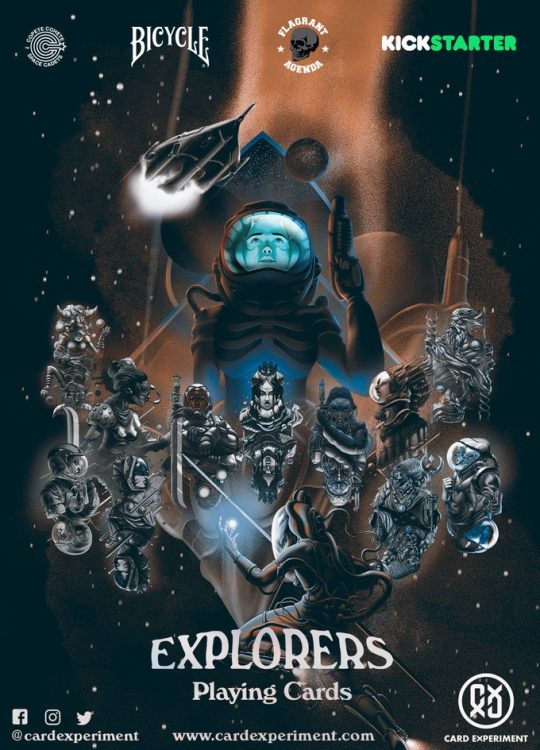
First contact with sapient, extraterrestrial lifeforms can be a
monumental moment in history or it can be the end of history as we know
it. When it happens, reality goes beyond the wildest expectations. The
truth goes even deeper, revealing a greater power orchestrating everything.
The Explorers deck explores human contact with an alien civilization
through a graphic novel-like visual extravaganza, highlighting the
sameness of braving interstellar frontiers with exploration in the Age
of Discovery albeit with a twist.

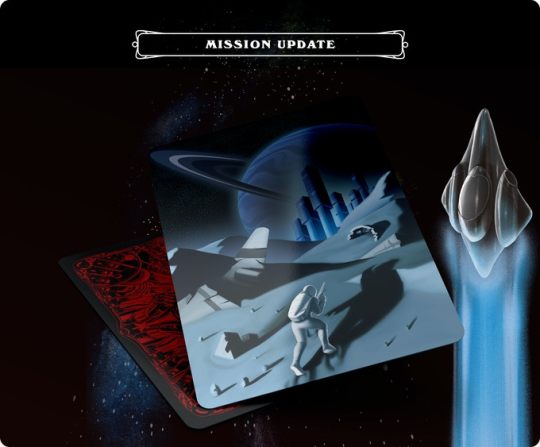
We are finally reaching our destination – an earth-like rock situated in the Goldilocks zone of a binary star system. Light signature detected by the Colossus Novus space telescope determine, with 99.9% likelihood, that intelligent life exists on the planet.
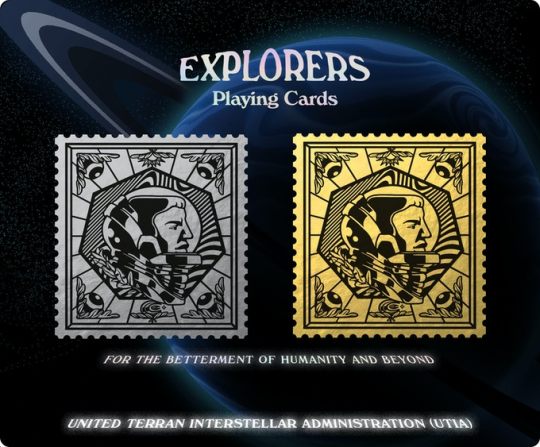
Custom foil seal (Stretch goal) – Unlock at $26000 USD
The United Terran Interstellar Administration put together the largest and most complex mission in record time. I was chosen, by virtue of my neutrality and perhaps my two-facedness and uncanny ability to make the best of any situation, to be the main point of contact when first contact happens. I am also to be the scribe of all mission logs. Lots of trust in me. My resemblance to the Administration emblem might play a part too.
While the mission objective is to establish peaceful contact, will this turn out to be another Columbian Exchange?

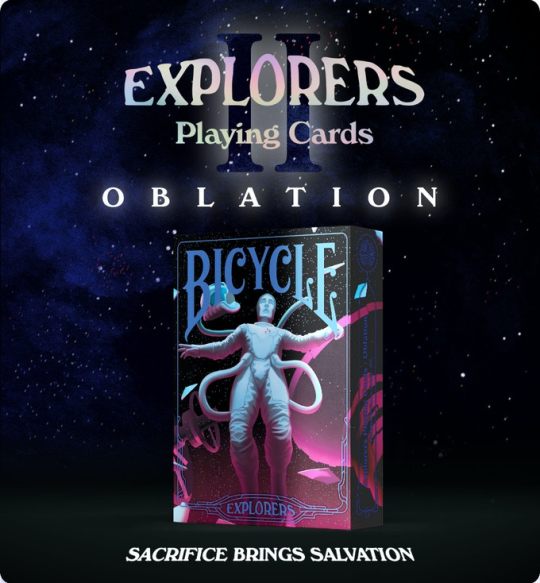
The Explorers Oblation deck will be unlocked at $45,000 USD as add-on


The core of our fleet is made up of 4 state-of-the-art interstellar spaceships. Meet Fiasco and Solaris, our main star cruisers, providing reconnaissance and offensive support. I do hope that we do not need to resort to the latter. However, firepower is always good to have, especially in our situation.
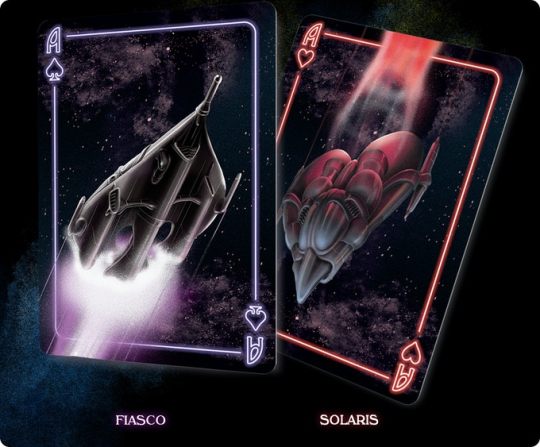
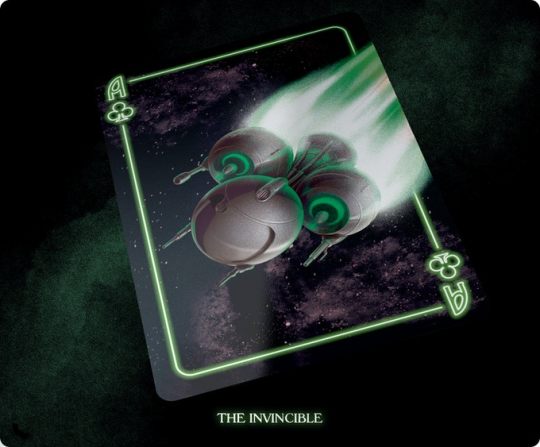
Our flagship is The Invincible. This monstrous machination is the most powerful interstellar space carrier that humanity has ever built.
However, my baby is Eden. Whether I can find myself safely on the surface of the planet depends on this planetary lander.
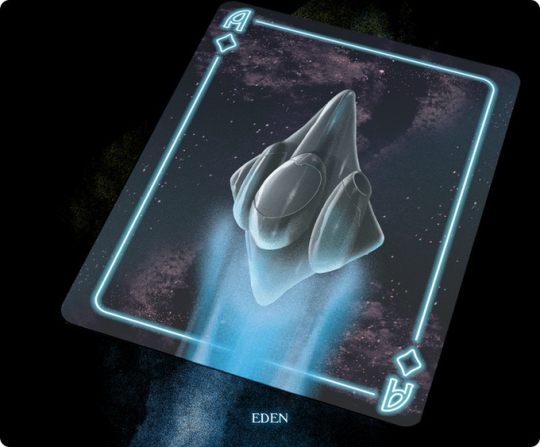
Apparently, the Director of the Administration is a reputable scholar of Lemean literature, a corpus of ancient sci-fi books, and found it apt to name the ships after the classics that focused on first contact. From my barely enough knowledge of these classics, I recalled that the first contact told in the classics did not end well. Let’s hope that ours end well.

The fleet crew is deliberately lean. Most of the operations are fully automated and taken care of by the latest droid models. The crew is also split into different hibernation schedule. I was in hibernation for the better part of the mission and was only recently de-hibernated. Seventy two hours ago to precise.
The Enforcer was the first face I saw when I woke up. He is from a lineage of distinguished war heroes. His great grandfather and granduncles fought in the Great War 250 years ago that seeded the establishment of Pax Terran.

The Engineer was in the same hibernation schedule as me. He was a brilliant self-taught inventor that was co-opted into the construction of the fleet. He volunteered to be part of the mission mainly because of the desire to see and touch alien technology first hand.

The Commander looks and feels different. One of the founding member of the Society for Advancement of Humanity, I remembered him to be an energetic and steadfast man, his deeply held beliefs on the Mutual Accelerated Development doctrine. He was chosen precisely for those qualities. The journey must have taken a toll on him.
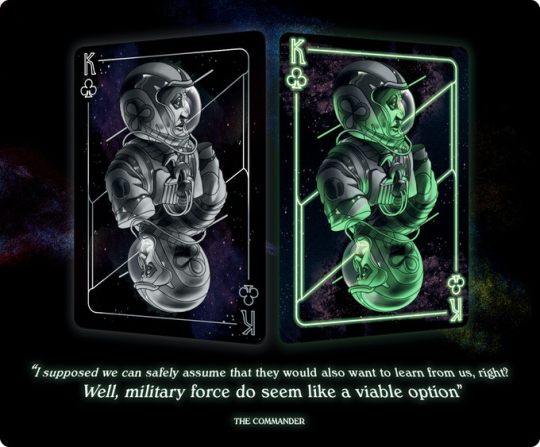
The Navigator is another high flyer. A top graduate from the Terran Space Academy, he was intimately involved in this mission through test flights of the Eden. His other escapades included an exploration and detailed mapping of the outer Asteroidal Belt and safely landing a planetary cruise on Uranus after an alleged terrorist attack.
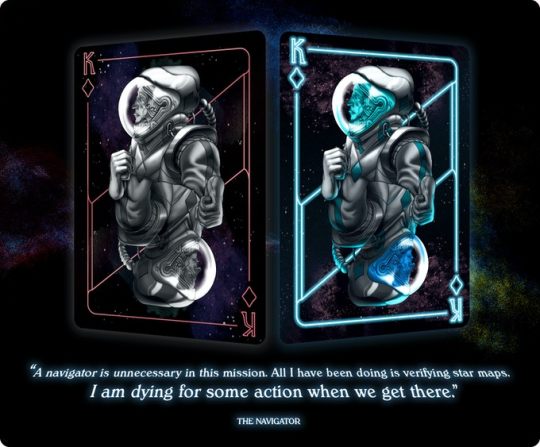
There are two other members of the crew who are still in hibernation. I will make another round of assessment after their de-hibernation, which will happen when we are about to reach our destination.

We had our first contact with extraterrestrials 6 hours ago in a pre-landing, near-orbital reconnaissance mission. Kadza I, named after the astrophysicist that first detected and analyzed the light signatures, has a bleak landscape, with traces of civilization restricted to isolated pockets. This is in contrast to what the light signatures suggested. Either the light signatures had significant measurement error or that something of planet-wide implications happened in between.
The contact was unexpected and surprising. The extraterrestrials were uncannily humanoid like exteriorly. They were wearing helmets hence we were unable discern their facial features. They had thruster-like contraceptions on their legs and armed with spear-like armaments. It is unknown how they ascend to orbital heights.
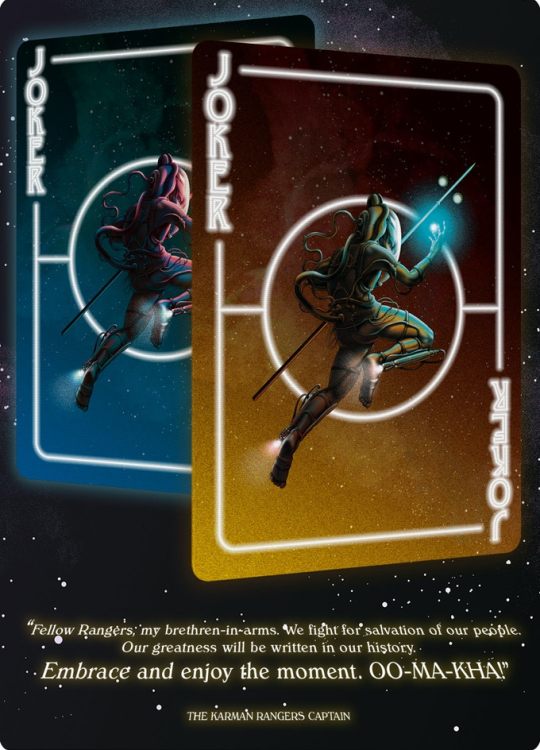
There was no attempt in establishing any form of communication. We were attacked by small projectiles that emitted fiery illumination. It is again unknown how these projectiles were propelled. Incredibly, some of these projectiles managed to breach Fiasco’s Titanium-Diamond alloy hull. The Commander authorized the Enforcer to launch a full-scale counter attack using high precision laser cannons. The extraterrestrials were vaporized and completely annihilated within fifteen minutes of engagement.
Back at the Invincible, the Engineer assessed the damage of Fiasco and deemed it unfit for any future deployment. The Scientist, one of the two most recently de-hibernated fleet crew, proposed to salvage any potential extraterrestrial biological materials left from the skirmish that we just had.

The Scientist is a exobiologist with an eclectic mix of expertise in interstellar human psychology, sociology, extreme material science and trans organic chemistry. She is also a recipient of two Nobel Prizes, one in Physiology and another in Human Sciences for her pioneering work in theoretical exobiology (there wasn’t any empirical work until now anyhow) and psychological impact of interstellar travel on human beings.
The Commander, under the advice of the Enforcer, ordered an all-out offensive prior to landing on planet to neutralize all threats. The Vice Commander vehemently protested against this decision.

The Vice Commander is a complicated woman. Prior to her appointment in UTIA, she served as Chief of Staff in the United Terran Defense Corp. She was instrumental in the formation of interplanetary defense plans as well as various covert, supposedly peacekeeping missions in the Asteroidal Colonies that suppressed separatist and terrorist elements.
The heated argument ended with a stand down order by the Commander to the Vice Commander and the Enforcer escorting her to her quarters. I have a bad feeling about this.

The offensive was a disaster. Kadza I was bombarded by Solaris and combat drones were sent in with the Eden. The Commander, the Enforcer and I were part of that expedition. It was a tactical mistake. The Eden was attacked by the same projectiles, larger in size and higher in intensity, during entry into Kadza I atmosphere and crash landed. The combat drones were completely ineffective against the projectiles and were thoroughly destroyed. The Commander and the Enforcer were KIA and I was captured.
The extraterrestrials have human-like facial features. The features are slightly alien yet familiar. This corroborated with the genetic investigations conducted by the Scientist. Genetically, we are 99.5% similar. These extraterrestrials, I called them Human Counterparts, the Scientist called them Homo Sapiens Extraterrestris, seem to possess some form of telepathic abilities.
I was brought in front of their leaders and was interrogated. Their language was unintelligible to me but I could understand the gist of their discussion. The understanding seems to diffuse into my mind especially when this particular individual, the Matriarch, was speaking to me.

A blight has been afflicting them for almost 20 years and it seems like a thousand-year prophecy stated that we, what they called the Sidereal Beings, will appear and by defeating us and performing a sacrificial ritual, the blight will end and their civilization will receive salvation from a higher power.


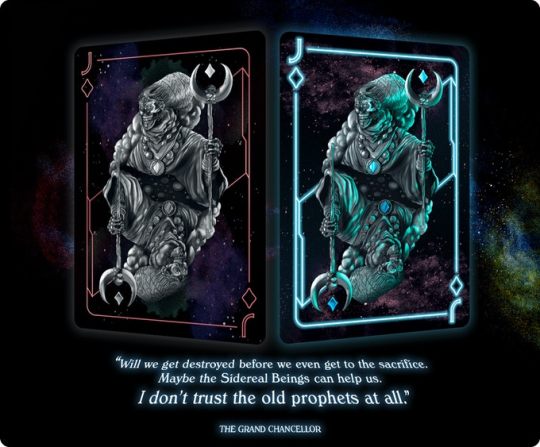
They were also discussing plans on reverse engineering our weapons and using them against us. Their prophecies were astonishingly accurate in many aspects of our mission and it seemed that they have been preparing themselves for our arrival for centuries.


I was rescued by the Engineer and the Navigator. The Engineer managed to restructure and reconfigure the Solaris to allow it for planetary landing. However, during the escape, Solaris was hit by the same projectiles the three of us had to evacuate via the escape pods. We encountered the same extraterrestrials that could ascend to orbital heights and the Navigator’s pod was destroyed before the Invincible came close enough to repel the extraterrestrials attack party and pick up the Engineer and me.

This is my personal entry and is not an official record. The whole mission was full of unanswered questions and mysteries.
Why was Kadza I not discovered for so many years after the deployment of Colossus Novus? The binary star system was not unknown to us and have been scrutinized by other astrophysicists before Griton Kadza spotted the irregularities in the light signatures.
Why did the extraterrestrials resembled us? Why did they have prophecies that accurately our arrival and how we operate? Why did their blight coincided with our mission?
So many questions and few answers. It seems that there is some hidden higher powers that is orchestrating all these. Am I being paranoid?
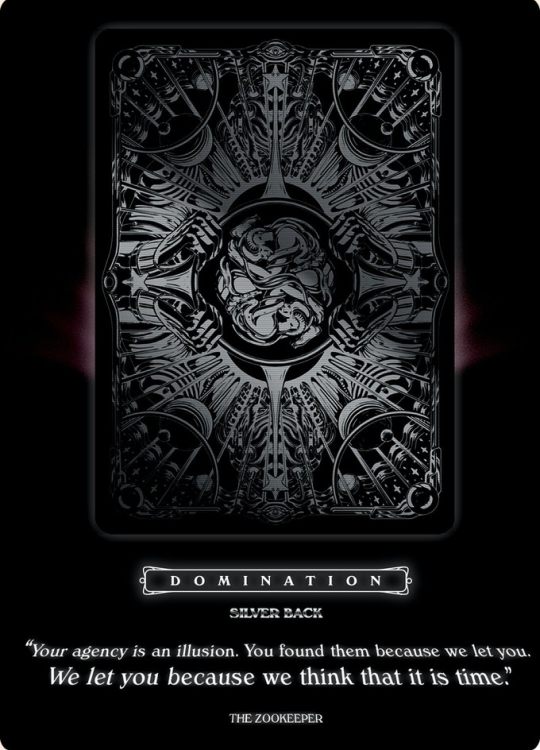


The Explorers Oblation deck will be unlocked at $45,000 USD as add-on
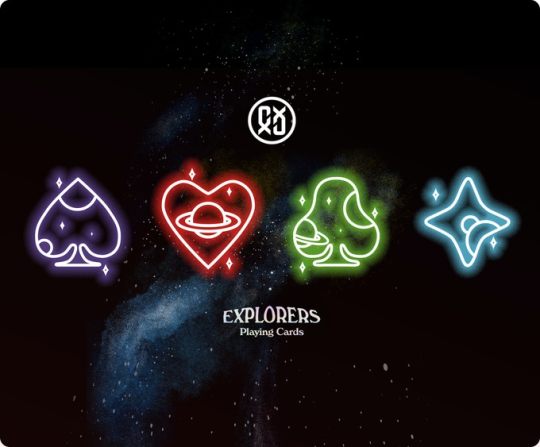






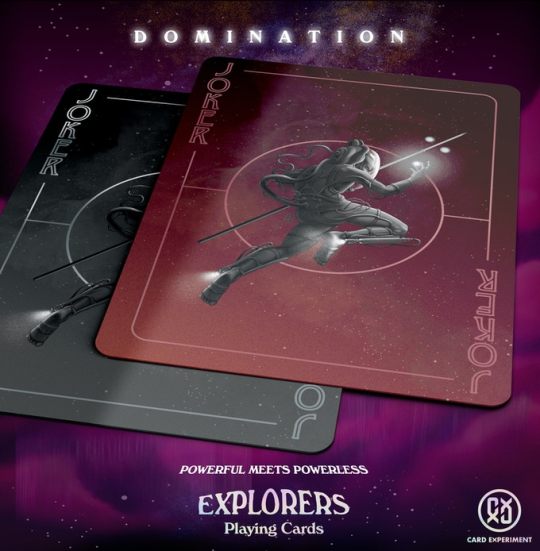

Explorers Domination deck Features:
Printed by The United States Playing Card Company. Made in USA
Silver Rainbow Foil paper tuckcase
Casino quality Bee® paper stock with Magic Finish (Air-cushion)
Metallic silver color card back
Spades & Clubs (Silver), Hearts & Diamonds (Red & Silver)
Custom silver foil seal (unlock at $26,000 USD)
Embossing (unlock at $32,200 USD)
Inner tuckcase printing (unlock at $41,000 USD)




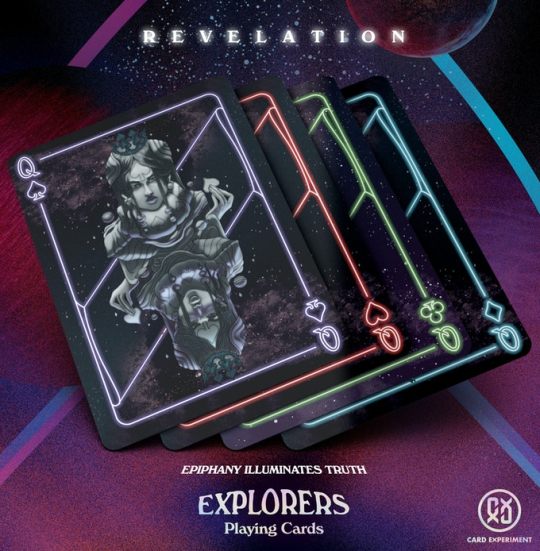
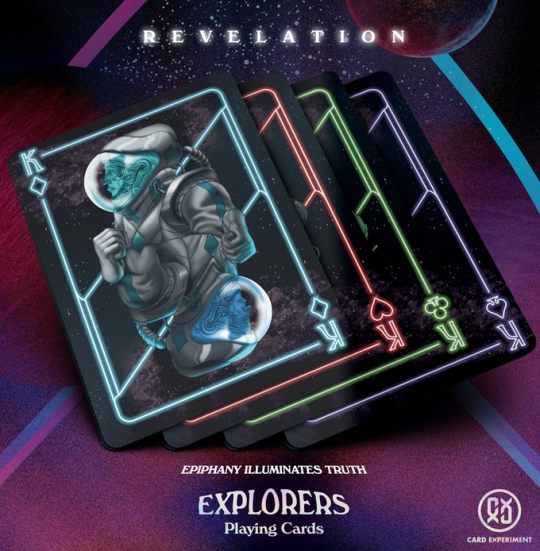

Explorers Domination deck Features:
Printed by The United States Playing Card Company. Made in USA
Silver Rainbow Foil paper tuckcase
Casino quality Bee® paper stock with Magic Finish (Air-cushion)
Red color card back
Spades (Purple), Hearts (Red), Clubs (Green), Diamonds (Blue)
Custom gold foil seal (unlock at $26,000 USD)
Embossing (unlock at $36,000 USD)
Inner tuckcase printing (unlock at $41,000 USD)






Explorers Oblation deck Features:
Printed by The United States Playing Card Company. Made in USA
Casino quality Bee® paper stock with Magic Finish (Air-cushion)
Metallic blue ink on card back and tuckcase
Spades & Clubs (Blue), Hearts & Diamonds (Red)
A different card back from Explorers Domination and Revelation

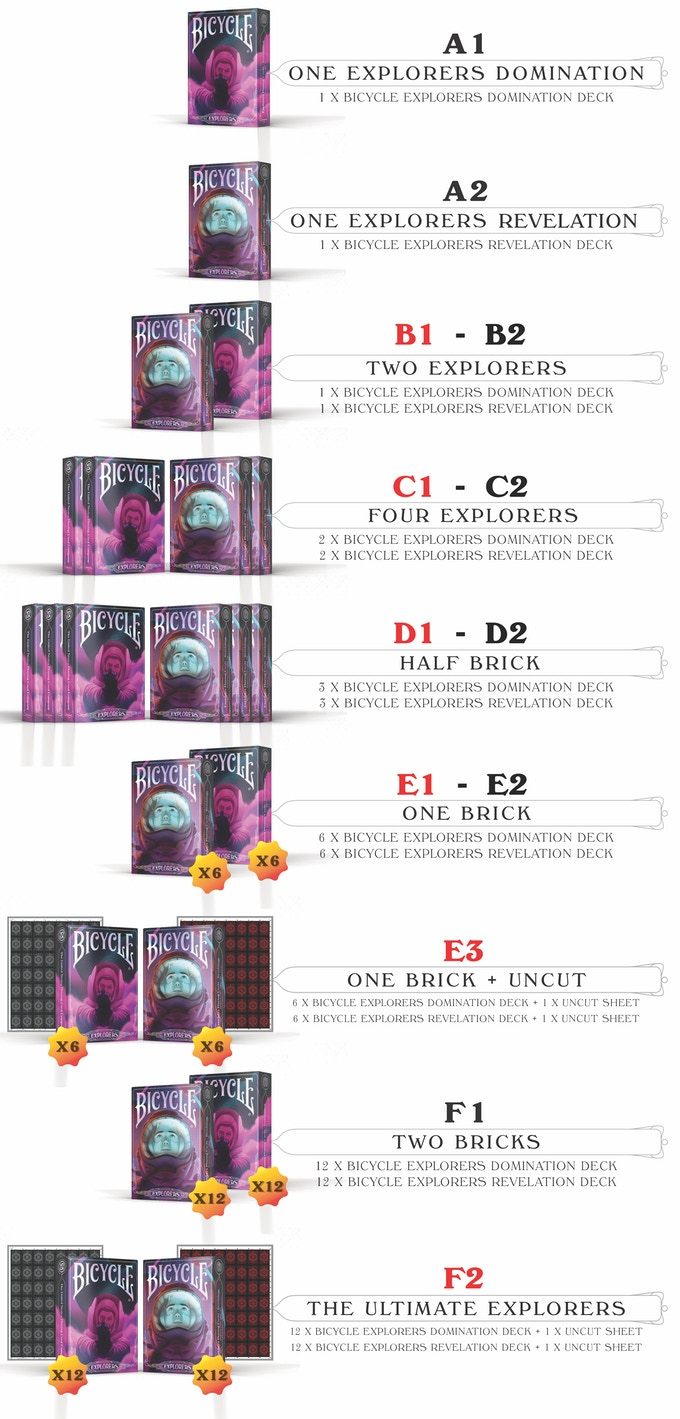



You must already be a backer and pledging for a tier to add on extra items from this list. All you have to do is increase the pledge amount according to each add-ons price.
You will be able to specify which add-ons you wanted at the end of the campaign in the survey. PM us if you have any questions.


At Card Experiment, other than pursuing our vision of making playing cards a medium for communicating, and provoking thought on complex ideas and themes, we are also dedicated to our mission of collaboration and co-creation, especially with artists all over the world, in all our projects.
These beliefs, once again, are exemplified in our current offering, the Explorers deck. In the Explorers deck, we toyed with the concepts of space exploration, first contact, and many other sci-fi tropes.
In terms of visuals, we teamed up with Copete Cohete, a design studio from Mexico City that delves into diverse portfolios and displays unique graphical style, to create amazing graphic novel style artworks that highlighted the intricate ideas that we want to communicate.
In terms of further enhancing the concepts through narratives, we worked with Flagrant Agenda, an apparel brand from Singapore that feature strong concepts behind their apparels, to compose a fascinating story that attempts to connect the various characters depicted in the artworks.
The visuals and narratives are greatly augmented by working closely with The United States Playing Card Company, a key collaborator whom we have a long standing relationship from our previous projects. The quality of their printing is second to none and the handles and feels that their cards provide have always been and definitely will be the crowning features for our projects and the Explorers deck.
This wonderful collaboration and co-creation of the Explorers deck would be incomplete without your support. We appeal to all of our supporters out there to lend us your helping hands so that we can make the Explorers deck a reality.
We are constantly pushing the boundaries of playing cards design by exploring complex themes. The playing cards that we have produced so far include the Asura deck, Babel deck, Utopia deck, Anicca deck, Dream deck and Artilect deck.

Bicycle Asura Playing Cards (Black Gold)

Bicycle Asura Playing Cards (Black)
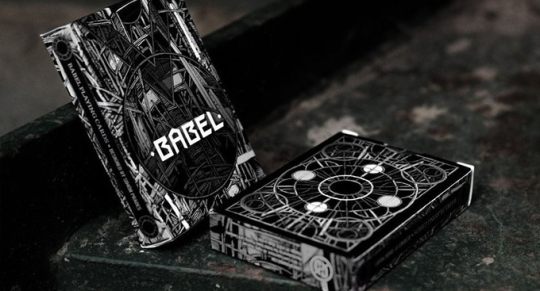
Babel Playing Cards (Black)

Babel Playing Cards

Bicycle Anicca Playing Cards (Metallic blue)

Anicca Playing Cards

Bicycle Utopia Playing Cards (Black Gold)

Artilect Playing Cards

Bicycle Dream Playing Cards (Silver & Gold)

Bicycle Dream Playing Cards



INFORMATION PROVIDED BY Kickstarter.com and Kicktraq.com
VISIT PAGE SOURCE
0 notes
Text
Boston Mayor Walsh Unveils Plan for Boston’s Waterfront to Protect the City
BOSTON – Boston Mayor Martin J. Walsh has rolled out a comprehensive and transformative vision that will invest in Boston’s waterfront to protect the City’s residents, homes, jobs, and infrastructure against the impacts of rising sea level and climate change.
Announced in his annual speech to the Greater Boston Chamber of Commerce, the Mayor’s plan, “Resilient Boston Harbor,” lays out strategies along Boston’s 47-mile shoreline that will increase access and open space along the waterfront while better protecting the city during a major flooding event.
“We’re not just planning for the next storm we’ll face, we’re planning for the storms the next generation will face,” said Mayor Walsh. “A resilient, climate-ready Boston Harbor presents an opportunity to protect Boston, connect Boston, and enhance Boston, now and for the future. As we enter a new era in our Harbor’s history, Boston can show the world that resilience is not only the ability to survive adversity, but to emerge even stronger than before. That’s the promise of a Resilient Boston.”
Mayor Walsh
Resilient Boston Harbor builds off of Imagine Boston 2030 and uses the City’s Climate Ready Boston 2070 flood maps and coastal resilience neighborhood studies to focus on Boston’s most vulnerable flood pathways. The strategies laid out in the plan include elevated landscapes, enhanced waterfront parks, flood resilient buildings, and revitalized and increased connections and access to the waterfront. The strategies will require collaboration and funding between federal, state, private, philanthropic and nonprofit partners.
East Boston, Charlestown:
Based on early recommendations from the City’s Climate Ready Charlestown and Climate Ready East Boston plans, a deployable floodwall system has been installed across the East Boston Greenway, and a section of Main Street in Charlestown is being elevated. Additional measures identified include:
Redesign Constitution Beach to combine flood protection with expanded access and recreation.
Enhance Wood Island and Belle Isle to prevent the loss of the last remaining tidal salt marsh in Boston, while buffering the shoreline from increased waves and surges.
Work with new development projects, including Suffolk Downs, to integrate resiliency measures, increased open space, and community connections.
Elevate transportation corridors like Bennington Street and the East Boston Greenway to create both flood protection and pedestrian connections throughout the neighborhood.
Elevate Main Street as part of the re-design of Rutherford Avenue and Sullivan Square, to block the primary flood pathway through Charlestown. $4.8 million in capital funding has already been committed to the overall project.
Elevate and renovate Ryan Playground.
Redevelop the Schrafft Center waterfront with elevated parks and mixed-use buildings to grow economic opportunity while restoring natural resources.
North End, Downtown:
Flood risks threaten Boston’s financial center, historic waterfront, tourist destinations and residential neighborhoods. The City will launch Climate Ready Downtown to further study the impacts and necessary measures to protect these neighborhoods. Strategies already identified include:
Redesign Christopher Columbus Park and Langone Park and Puopolo Playground to include elevation to protect against flooding while improving waterfront open space and connections to the Rose Kennedy Greenway.
Transform the parking lot at Sargent’s Wharf into a combination of open space and resilient small-scale development.
Elevate sections of the Harborwalk.
Enhance Long Wharf as the gateway for water transportation.
South Boston, Fort Point:
Released today, Climate Ready South Boston identifies the major flood pathways to many of the City’s residential neighborhoods through Fort Point Channel and Moakley Park. In response, the following strategies have been identified:
Create a resilient Moakley Park and a re-envisioned Fort Point Channel to protect homes and businesses in South Boston, the South End, Chinatown, and parts of Dorchester and Roxbury.
Build a coalition of support from the private property owners surrounding Fort Point Channel to assist in creating a signature resilient park system.
Complete the Emerald Necklace from Franklin Park to Moakley Park along Columbia Road to increase access to the waterfront. $11 million will be allocated from sale of the Winthrop Square Garage for this project.
Secure federal support. The City is applying for a $10 million FEMA mitigation grant to begin resilience work along the Fort Point Channel.
The Boston Water & Sewer Commission has begun installing essential infrastructure for reducing flood risk.
An elevated New Ellery Street along the Dorchester Avenue corridor in South Boston, as identified in the BPDA’s PLAN: Dorchester Avenue South Boston to provide additional flood protection for South Boston’s residential neighborhoods.
Complete Martin’s Park, an inclusive waterfront playground that will be climate-ready.
Dorchester Waterfront:
In order to create a resilient, more accessible Dorchester shoreline with increased connectivity, the City will launch Climate Ready Dorchester. Strategies already identified, include:
Re-design Morrissey Boulevard to stop current and future flooding, and open up the waterfront.
Complete the connection of the Neponset River Trail in Mattapan to the Harborwalk from Tenean Beach to Victory Park.
Work with UMass Boston to further open up the waterfront along Columbia Point for the residents of Dorchester.
Work with residents on new and improved amenities for the neighborhood, including better public transit and improved roadway, pedestrian, and bike connections.
Resilient Boston Harbor builds on the investments the City of Boston has made under Mayor Walsh to increase the City’s climate resiliency, including:
Released Climate Ready Boston, an internationally recognized plan that builds on Imagine Boston 2030.
Became one of the first cities to set a target of carbon neutrality by 2050. This week, the City released a Request for Proposals (RFP) for the next update to Boston’s Climate Action Plan that will create a roadmap for that goal.
Expanded open space. Boston ranks first in the nation for resident access to parks.
Making historic investments in green transportation, including protected bicycle lanes in Roxbury, the South End, and North End, and expanded bike share access in Mattapan, Roslindale, and Dorchester.
Completing new resilient design standards for public infrastructure, providing ways for all construction on public rights-of-way to adopt flood protection measures.
The BPDA updated the climate resiliency checklist, requiring new projects to show they are resilient to climate impacts, and is designing a flood resiliency zoning district that will strengthen requirements for new and retrofitted buildings.
Hosting the International Climate Summit in June, where the Mayor led the creation of a new coalition of cities dedicated to buying renewable energy collectively.
Today, Boston is the top-ranked city for energy policy by the American Council for an Energy Efficient Economy, and rating agencies cite Boston’s climate work in support of the City’s triple-A bond ratings.
The projects outlined in Resilient Boston Harbor will require a number of different funding sources. Mayor Walsh announced that the City of Boston will commit 10 percent of all new capital funding to resilience projects. He called on Boston’s state and federal government partners, as well as the private sector and non-profit and philanthropic stakeholders to join the City in committing to make these necessary investments a reality.
The strategy builds on the City of Boston’s Resilience Strategy. Boston’s resilience strategy is focused on ensuring every resident can reach their full potential regardless of their background, and removing the barriers of systemic racism that hinder Bostonians from having access to opportunities.
Stakeholder Statements of Support:
“We have an economic and moral imperative to act on climate change,” said Senator Edward J. Markey. “This requires leaders at all levels of government and our business sector to work collectively to address the challenges facing our communities. As the Co-Chair of the U.S. Senate’s Climate Change Task Force, I am committed to standing with local leaders, like Mayor Walsh, to be the strong federal partner our residents need as the world continues to warm and sea levels rise.”
“Building a resilient city is a serious challenge in response to a sobering threat, but it also brings enormous opportunity to re-think our relationship to the Harbor and create a world-class waterfront,” said Kathy Abbott, President and CEO of Boston Harbor Now. “We commend Mayor Walsh for seizing this moment to design a waterfront that is more accessible, beautiful, and inclusive than ever before. The urgency of climate change requires all of us to step up and work together like never before.”
“Resilient Boston Harbor will not only strengthen the City against the impacts of climate change, it will create a fantastic urban waterfront, opening up many new opportunities to improve public access to the Harbor,” said Bud Ris, Senior Advisor to the Boston Green Ribbon Commission. “Based on all of the analyses that have been done through Climate Ready Boston so far, this is exactly the kind of approach Boston should be taking. We look forward to continuing our partnership with the City to make Resilient Boston Harbor a reality.”
“Given the urgency needed to address climate change, it is exciting to see the City of Boston put forth such a bold vision for the future,” said Rebecca Herst, the Executive Director of the Sustainable Solutions Lab at UMass Boston, “This is a real opportunity to keep Bostonians safe from flooding and invest in our communities. With strong leadership, driven by scientific research, policy analysis and deep community engagement, we can ensure that all Boston residents, not just those with means, are prepared for climate impacts.”
“I want to thank Mayor Walsh for launching Climate Ready Dorchester,” said District 3 City Councilor Frank Baker. “I look forward to participating in that process and encourage my constituents to get engaged and discuss how we can increase access to our beaches while protecting our homes and roads from future flooding.”
“I applaud Mayor Walsh for his continued efforts to make Boston resilient for future generations,” said State Representative Adrian Madaro. “Climate change is one of the greatest challenges facing our City and our planet. The plan announced today will not only protect Boston’s waterfront neighborhoods, but will also improve the quality of life for our residents.”
from boston condos ford realtor https://bostonrealestatetimes.com/boston-mayor-walsh-unveils-plan-for-bostons-waterfront-to-protect-the-city/
0 notes
Link
The following blog post, unless otherwise noted, was written by a member of Gamasutra’s community.
The thoughts and opinions expressed are those of the writer and not Gamasutra or its parent company.
[Video Game Deep Cuts is a weekly newsletter from curator/video game industry veteran Simon Carless, rounding up the best longread & standout articles & videos about games, every weekend. This week's highlights include a GDC talk on 'the aesthetics of cute', the hidden story of TOSE, & the return to car wrecking of key Burnout developers.
Another interesting week of longer-form 'things', and I've been ruminating a bit on how these videos and articles intersect in weird but neat ways with 'breaking news' or 'hottest games'. Seems like you'll get at least _some_ bleed-through - for example, this week we have Battlegrounds, Signal From Tolva & Night In The Woods again, all of which are newish or interesting releases.
But many of these pieces are evergreen & exist separately of the 'hot reactions' grind. Which is good. Exist too close to the 24-hour hype cycle, and you'll miss trends and more thoughtful takes like some of these good folks. VGDC aims to reverse that. We hope you think we do a good job.
- Simon, curator.]
-------------------
Guild Wars 2’s art style passes from father to son (Philippa Warr / RockPaperShotgun)
"Recently I had the chance to talk to ArenaNet (and thus Guild Wars 2) art director Horia Dociu about his work at the studio. One of the interesting things about his promotion to the role is that he succeeds his father, Daniel."
We’ve been missing a big part of game industry’s digital revolution (Kyle Orland / Ars Technica)
"Last year, the Entertainment Software Association's annual "Essential Facts" report suggested that the US game industry generated $16.5 billion in "content" sales annually (excluding hardware and accessories). In this year's report, that number had grown to a whopping $24.5 billion, a nearly 50-percent increase in a span of 12 months. No, video games didn't actually become half again as popular with Americans over the course of 2016. Instead, tracking firm NPD simply updated the way it counts the still-shadowy world of digital game sales."
Warren Spector believes games 'need to be asking bigger questions' (Alex Wawro / Gamasutra)
"Gamasutra sat down with Spector at GDC last month to catch up on how the process is going, roughly a year into his full-time gig at OtherSide. It was an interesting conversation, especially if you're at all interested in where games are at these days, where they came from, and what sorts of stories they're best at telling."
A Rare Look Inside Nintendo (Otaku / Game Escape / YouTube)
"This clip is an excerpt from the French documentary film "Otaku" by director Jean-Jacques Beineix from 1994. It appeared dubbed on German TV some time later, which is the version you are seeing here. It has, to my knowledge, never been released in English. The subtitles are my own. Content is the intellectual property of the original rights holders."
An Interview With One of Those Hackers Screwing With Your 'Black Ops 2' Games(Patrick Klepek / Waypoint)
"He's not there to ruin your stats. He's there to sell you software that'll let you launch a DDOS attack from your Xbox 360. [SIMON'S NOTE: this is crazy - modded Xbox 360s that find other player's IP addresses and can DDOS them?! I had no idea.]"
Put a Face on It: The Aesthetics of Cute (Jenny Jiao Hsia / GDC / YouTube)
"In this 2017 GDC session, Hexecutable's Jenny Jiao Hsia explains why cuteness as an aesthetic may be worth exploring for developers who want to push against current trends in game design."
Proc. Gen. and Pleasant Land | Sir You Are Being Hunted (Robert Seddon / Heterotopias)
"It was a perfect rustic idyll, in its way. Perfectly lovely, nestled between the grassy fields. Perfectly quiet, as only dead places can be. Perfectly still, because a player careless enough to create a disturbance might attract the robotic hunters. Big Robot’s Sir You Are Being Hunted had, through the digital governance of its landscape generation algorithms, somehow perfected the British countryside."
How video games were made - part 3: Marketing and Business (Strafefox / YouTube)
"In this final chapter we cover the business side and marketing of 8 and 16 bit games. [SIMON'S NOTE: Lots of archival footage in here & SO much work cutting it all together - and the other entries in the 'how video games were made' series look pretty good too!]"
Video Games Are Better Without Stories (Ian Bogost / The Atlantic)
"A longstanding dream: Video games will evolve into interactive stories, like the ones that play out fictionally on the Star Trek Holodeck. In this hypothetical future, players could interact with computerized characters as round as those in novels or films, making choices that would influence an ever-evolving plot. [SIMON'S NOTE: lots of responses to this all over the Internet - here's a couple of good ones from the Waypoint folks.]"
'Burnout' Series Creator Talks Remaking Crash Mode for 'Danger Zone' (John Davison / Glixel)
"Spend longer than a few minutes talking with fans of driving games about which series they'd love to see revived, and invariably someone will bring up Criterion's Burnout. Unlike contemporaries that were leaning harder into realism and officially-licensed cars as a response to games like Gran Turismo, the first Burnout – released by Acclaim for PlayStation 2 in 2001 – was unapologetically action-focused."
Famitsu Special Report – The Mystery of TOSE (Famitsu / One Million Power)
"This is the real story behind TOSE: The game development company that’s been making games for nearly 38 years (since 1979), but hardly any gamers know. [SIMON'S NOTE: Brandon Sheffield covered TOSE for Gamasutra back in 2006, but by and large, they've been PRETTY vague about what they work on - which is fascinating.]"
How Three Kids With No Experience Beat Square And Translated Final Fantasy V Into English (Jason Schreier / Kotaku)
"One day in the late 1990s, Myria walked into the Irvine High School computer room and spotted a boy playing Final Fantasy V. There were two unusual things about this. The first was that Final Fantasy V had not actually come out in the United States."
Night in the Woods is Important (HeavyEyed / YouTube)
"An analysis of the recently released game - this video contains very minimal spoilers but watch at your own discretion.."
Designing the giant battle royale maps of Playerunknown's Battlegrounds (Alan Bradley / Gamasutra)
"For Brendan "Playerunknown" Greene, the creator of Battlegrounds, the vision for his game world was born from extensive experience creating and manipulating environments that direct players to play his games the way he intends them to be played."
All We Have Is Words (Matthew Burns / Magical Wasteland)
"Sometimes I give the impression of knowing Japanese, but I really don’t. I have no claim to it. I never made a real study of the language, I don’t know kanji and thus can’t read at all, and even in speech I can’t exchange more than pleasantries or the most rudimentary logistical information. [SIMON'S NOTE: I believe this is a subtle 'subtweet'-style article response to the recent Persona 5 translation furore? Maybe?]"
Changing the Game: What's Next for Anita Sarkeesian (Laura A. Parker / Glixel)
"Anita Sarkeesian’s talk at this year’s Game Developers Conference in San Francisco falls at an unfortunate time: 10am on the last day of the conference – a Friday. Most attendees – a mix of indie programmers, mainstream publishing teams and media – are still bleary eyed from the night before. And yet, at five-to-ten, the small room on the third floor of the Moscone Convention Center is standing-room only."
The quest to crack and preserve vintage Apple II software (Leigh Alexander and Iain Chambers / The Guardian Podcast)
"Why has the quest to hack old Apple II software become the best hope we have of preserving a part of our cultural history? How do these floppy discs – still turning up in their box-loads – shine a light on the educational philosophies of the 80s? And do a new generation of gamers risk losing whole days of their lives by playing these compelling retro games in their browsers?"
Video Games Help Model Brain’s Neurons (Nick Wingfield / New York Times)
"Since November, thousands of people have played the game, “Mozak,” which uses common tricks of the medium — points, leveling up and leader boards that publicly rank the performance of players — to crowdsource the creation of three-dimensional models of neurons."
Longtime 'Star Citizen' Backers Want Its New Referral Contest to Die in a Black Hole (Leif Johnson / Motherboard)
"Developers of multiplayer video games often host referral programs encouraging existing players to recruit their friends for a boost in cash flow, and in that regard, the new referral contest from Star Citizen developer Cloud Imperium Games isn't much out of the ordinary. The same can't be said of the reactions from the players themselves."
Localization Shenanigans in the Chinese Speaking World (Jung-Sheng Lin / GDC / YouTube)
"In this 2017 GDC session, IGDShare's Jung-Sheng Lin discusses a wide variety of possible issues that can arise when undertaking Chinese localization for your game. These problems include grappling simplified vs. traditional Chinese, naming problems, UI & fonts, and China-specific policies that may relate to localization, political implications, and more."
Good Game/Tech/History Youtubers (Phoe / Medium)
"[SIMON'S NOTE: this got birthed after a conversation I had with Phoe in the Video Game History Foundation Discord chat - he watches a lot of good retro/interesting YouTube, and there's a number of recommendations in here I was unaware of!]
Red Bull TV - Screenland (Red Bull TV)
"Plug into the fresh stories within the world of video games and game design. The personal tales, wild new developments, and unexpected genres shed new light on what gaming means in the world now and what it could mean in the future. [SIMON'S NOTE: this is an entire _season_ of gaming documentaries, including with Frank Cifaldi (Video Game History Foundation), UK cult classic Knightmare, and lots more.]"
Tim Schafer tells the story of Amnesia Fortnight (Philippa Warr / RockPaperShotgun)
"“I started feeling a little bogged down by the scope of [Brutal Legend],” says Tim Schafer, founder of Double Fine. “It was really huge and I felt like the team had been doing it for a long time and had a long way to go yet. I felt like they needed a break.” That break was Amnesia Fortnight, a two week game jam during which anyone at the developer can pitch an idea and, if it’s selected, lead a team to turn it from concept to working prototype."
The Signal From Tolva: The Best Game Ever (Matt Lees / Cool Ghosts / YouTube)
"New video! Matt dives into a spooky robot world, to talk about some of the cool design aspects of The Signal From Tölva. [SIMON'S NOTE: Can't emphasize enough that Cool Ghosts has some of the best game criticism on YouTube. Please patronize them! (On Patreon, not by talking down to them.)"
-------------------
[REMINDER: you can sign up to receive this newsletter every weekend at http://ift.tt/2dUXrva we crosspost to Gamasutra later on Sunday, but get it first via newsletter! Story tips and comments can be emailed to [email protected]. MINI-DISCLOSURE: Simon is one of the organizers of GDC and Gamasutra, so you may sometimes see links from those entities in his picks. Or not!]
0 notes
Link
The following blog post, unless otherwise noted, was written by a member of Gamasutra’s community.
The thoughts and opinions expressed are those of the writer and not Gamasutra or its parent company.
[Video Game Deep Cuts is a weekly newsletter from curator/video game industry veteran Simon Carless, rounding up the best longread & standout articles & videos about games, every weekend. This week's highlights include a GDC talk on 'the aesthetics of cute', the hidden story of TOSE, & the return to car wrecking of key Burnout developers.
Another interesting week of longer-form 'things', and I've been ruminating a bit on how these videos and articles intersect in weird but neat ways with 'breaking news' or 'hottest games'. Seems like you'll get at least _some_ bleed-through - for example, this week we have Battlegrounds, Signal From Tolva & Night In The Woods again, all of which are newish or interesting releases.
But many of these pieces are evergreen & exist separately of the 'hot reactions' grind. Which is good. Exist too close to the 24-hour hype cycle, and you'll miss trends and more thoughtful takes like some of these good folks. VGDC aims to reverse that. We hope you think we do a good job.
- Simon, curator.]
-------------------
Guild Wars 2’s art style passes from father to son (Philippa Warr / RockPaperShotgun)
"Recently I had the chance to talk to ArenaNet (and thus Guild Wars 2) art director Horia Dociu about his work at the studio. One of the interesting things about his promotion to the role is that he succeeds his father, Daniel."
We’ve been missing a big part of game industry’s digital revolution (Kyle Orland / Ars Technica)
"Last year, the Entertainment Software Association's annual "Essential Facts" report suggested that the US game industry generated $16.5 billion in "content" sales annually (excluding hardware and accessories). In this year's report, that number had grown to a whopping $24.5 billion, a nearly 50-percent increase in a span of 12 months. No, video games didn't actually become half again as popular with Americans over the course of 2016. Instead, tracking firm NPD simply updated the way it counts the still-shadowy world of digital game sales."
Warren Spector believes games 'need to be asking bigger questions' (Alex Wawro / Gamasutra)
"Gamasutra sat down with Spector at GDC last month to catch up on how the process is going, roughly a year into his full-time gig at OtherSide. It was an interesting conversation, especially if you're at all interested in where games are at these days, where they came from, and what sorts of stories they're best at telling."
A Rare Look Inside Nintendo (Otaku / Game Escape / YouTube)
"This clip is an excerpt from the French documentary film "Otaku" by director Jean-Jacques Beineix from 1994. It appeared dubbed on German TV some time later, which is the version you are seeing here. It has, to my knowledge, never been released in English. The subtitles are my own. Content is the intellectual property of the original rights holders."
An Interview With One of Those Hackers Screwing With Your 'Black Ops 2' Games(Patrick Klepek / Waypoint)
"He's not there to ruin your stats. He's there to sell you software that'll let you launch a DDOS attack from your Xbox 360. [SIMON'S NOTE: this is crazy - modded Xbox 360s that find other player's IP addresses and can DDOS them?! I had no idea.]"
Put a Face on It: The Aesthetics of Cute (Jenny Jiao Hsia / GDC / YouTube)
"In this 2017 GDC session, Hexecutable's Jenny Jiao Hsia explains why cuteness as an aesthetic may be worth exploring for developers who want to push against current trends in game design."
Proc. Gen. and Pleasant Land | Sir You Are Being Hunted (Robert Seddon / Heterotopias)
"It was a perfect rustic idyll, in its way. Perfectly lovely, nestled between the grassy fields. Perfectly quiet, as only dead places can be. Perfectly still, because a player careless enough to create a disturbance might attract the robotic hunters. Big Robot’s Sir You Are Being Hunted had, through the digital governance of its landscape generation algorithms, somehow perfected the British countryside."
How video games were made - part 3: Marketing and Business (Strafefox / YouTube)
"In this final chapter we cover the business side and marketing of 8 and 16 bit games. [SIMON'S NOTE: Lots of archival footage in here & SO much work cutting it all together - and the other entries in the 'how video games were made' series look pretty good too!]"
Video Games Are Better Without Stories (Ian Bogost / The Atlantic)
"A longstanding dream: Video games will evolve into interactive stories, like the ones that play out fictionally on the Star Trek Holodeck. In this hypothetical future, players could interact with computerized characters as round as those in novels or films, making choices that would influence an ever-evolving plot. [SIMON'S NOTE: lots of responses to this all over the Internet - here's a couple of good ones from the Waypoint folks.]"
'Burnout' Series Creator Talks Remaking Crash Mode for 'Danger Zone' (John Davison / Glixel)
"Spend longer than a few minutes talking with fans of driving games about which series they'd love to see revived, and invariably someone will bring up Criterion's Burnout. Unlike contemporaries that were leaning harder into realism and officially-licensed cars as a response to games like Gran Turismo, the first Burnout – released by Acclaim for PlayStation 2 in 2001 – was unapologetically action-focused."
Famitsu Special Report – The Mystery of TOSE (Famitsu / One Million Power)
"This is the real story behind TOSE: The game development company that’s been making games for nearly 38 years (since 1979), but hardly any gamers know. [SIMON'S NOTE: Brandon Sheffield covered TOSE for Gamasutra back in 2006, but by and large, they've been PRETTY vague about what they work on - which is fascinating.]"
How Three Kids With No Experience Beat Square And Translated Final Fantasy V Into English (Jason Schreier / Kotaku)
"One day in the late 1990s, Myria walked into the Irvine High School computer room and spotted a boy playing Final Fantasy V. There were two unusual things about this. The first was that Final Fantasy V had not actually come out in the United States."
Night in the Woods is Important (HeavyEyed / YouTube)
"An analysis of the recently released game - this video contains very minimal spoilers but watch at your own discretion.."
Designing the giant battle royale maps of Playerunknown's Battlegrounds (Alan Bradley / Gamasutra)
"For Brendan "Playerunknown" Greene, the creator of Battlegrounds, the vision for his game world was born from extensive experience creating and manipulating environments that direct players to play his games the way he intends them to be played."
All We Have Is Words (Matthew Burns / Magical Wasteland)
"Sometimes I give the impression of knowing Japanese, but I really don’t. I have no claim to it. I never made a real study of the language, I don’t know kanji and thus can’t read at all, and even in speech I can’t exchange more than pleasantries or the most rudimentary logistical information. [SIMON'S NOTE: I believe this is a subtle 'subtweet'-style article response to the recent Persona 5 translation furore? Maybe?]"
Changing the Game: What's Next for Anita Sarkeesian (Laura A. Parker / Glixel)
"Anita Sarkeesian’s talk at this year’s Game Developers Conference in San Francisco falls at an unfortunate time: 10am on the last day of the conference – a Friday. Most attendees – a mix of indie programmers, mainstream publishing teams and media – are still bleary eyed from the night before. And yet, at five-to-ten, the small room on the third floor of the Moscone Convention Center is standing-room only."
The quest to crack and preserve vintage Apple II software (Leigh Alexander and Iain Chambers / The Guardian Podcast)
"Why has the quest to hack old Apple II software become the best hope we have of preserving a part of our cultural history? How do these floppy discs – still turning up in their box-loads – shine a light on the educational philosophies of the 80s? And do a new generation of gamers risk losing whole days of their lives by playing these compelling retro games in their browsers?"
Video Games Help Model Brain’s Neurons (Nick Wingfield / New York Times)
"Since November, thousands of people have played the game, “Mozak,” which uses common tricks of the medium — points, leveling up and leader boards that publicly rank the performance of players — to crowdsource the creation of three-dimensional models of neurons."
Longtime 'Star Citizen' Backers Want Its New Referral Contest to Die in a Black Hole (Leif Johnson / Motherboard)
"Developers of multiplayer video games often host referral programs encouraging existing players to recruit their friends for a boost in cash flow, and in that regard, the new referral contest from Star Citizen developer Cloud Imperium Games isn't much out of the ordinary. The same can't be said of the reactions from the players themselves."
Localization Shenanigans in the Chinese Speaking World (Jung-Sheng Lin / GDC / YouTube)
"In this 2017 GDC session, IGDShare's Jung-Sheng Lin discusses a wide variety of possible issues that can arise when undertaking Chinese localization for your game. These problems include grappling simplified vs. traditional Chinese, naming problems, UI & fonts, and China-specific policies that may relate to localization, political implications, and more."
Good Game/Tech/History Youtubers (Phoe / Medium)
"[SIMON'S NOTE: this got birthed after a conversation I had with Phoe in the Video Game History Foundation Discord chat - he watches a lot of good retro/interesting YouTube, and there's a number of recommendations in here I was unaware of!]
Red Bull TV - Screenland (Red Bull TV)
"Plug into the fresh stories within the world of video games and game design. The personal tales, wild new developments, and unexpected genres shed new light on what gaming means in the world now and what it could mean in the future. [SIMON'S NOTE: this is an entire _season_ of gaming documentaries, including with Frank Cifaldi (Video Game History Foundation), UK cult classic Knightmare, and lots more.]"
Tim Schafer tells the story of Amnesia Fortnight (Philippa Warr / RockPaperShotgun)
"“I started feeling a little bogged down by the scope of [Brutal Legend],” says Tim Schafer, founder of Double Fine. “It was really huge and I felt like the team had been doing it for a long time and had a long way to go yet. I felt like they needed a break.” That break was Amnesia Fortnight, a two week game jam during which anyone at the developer can pitch an idea and, if it’s selected, lead a team to turn it from concept to working prototype."
The Signal From Tolva: The Best Game Ever (Matt Lees / Cool Ghosts / YouTube)
"New video! Matt dives into a spooky robot world, to talk about some of the cool design aspects of The Signal From Tölva. [SIMON'S NOTE: Can't emphasize enough that Cool Ghosts has some of the best game criticism on YouTube. Please patronize them! (On Patreon, not by talking down to them.)"
-------------------
[REMINDER: you can sign up to receive this newsletter every weekend at http://ift.tt/2dUXrva we crosspost to Gamasutra later on Sunday, but get it first via newsletter! Story tips and comments can be emailed to [email protected]. MINI-DISCLOSURE: Simon is one of the organizers of GDC and Gamasutra, so you may sometimes see links from those entities in his picks. Or not!]
0 notes